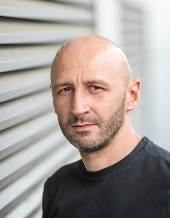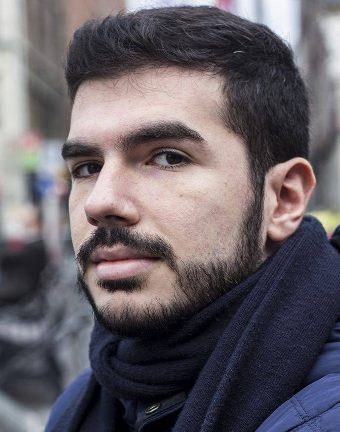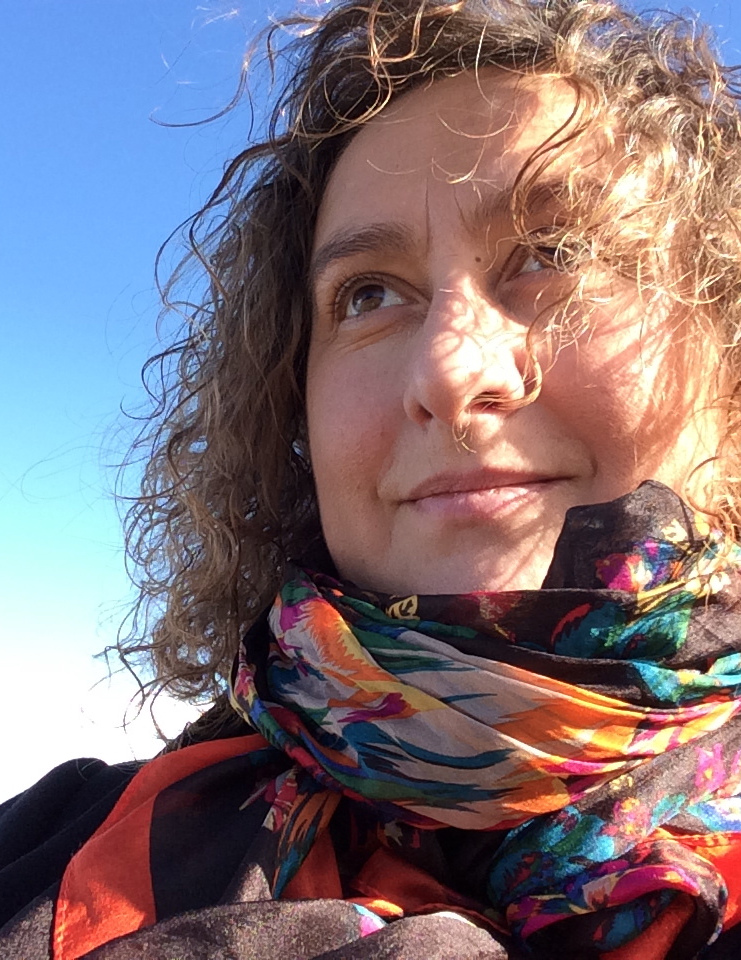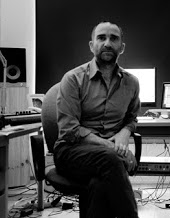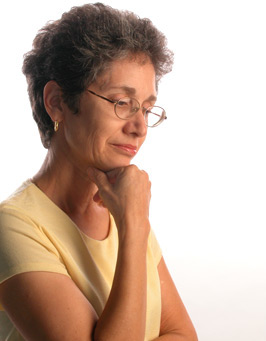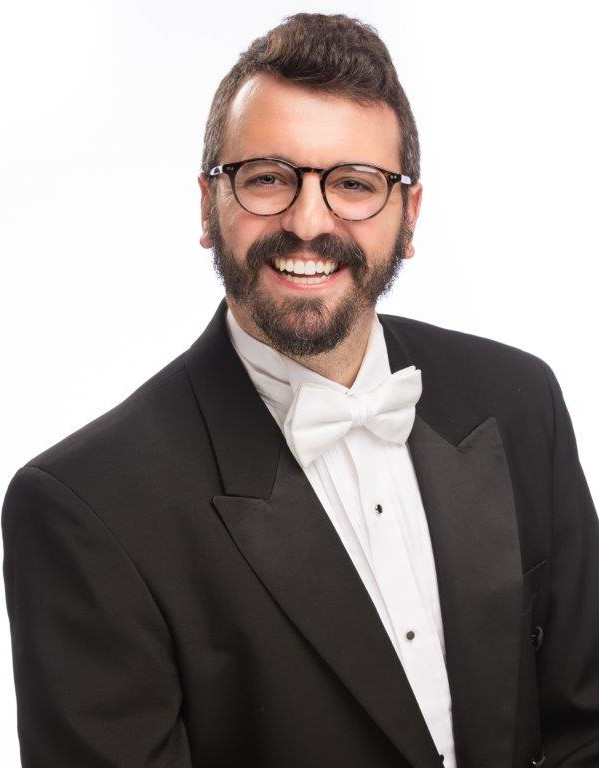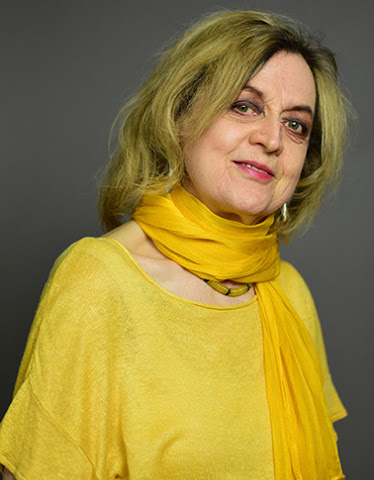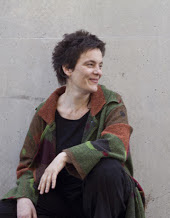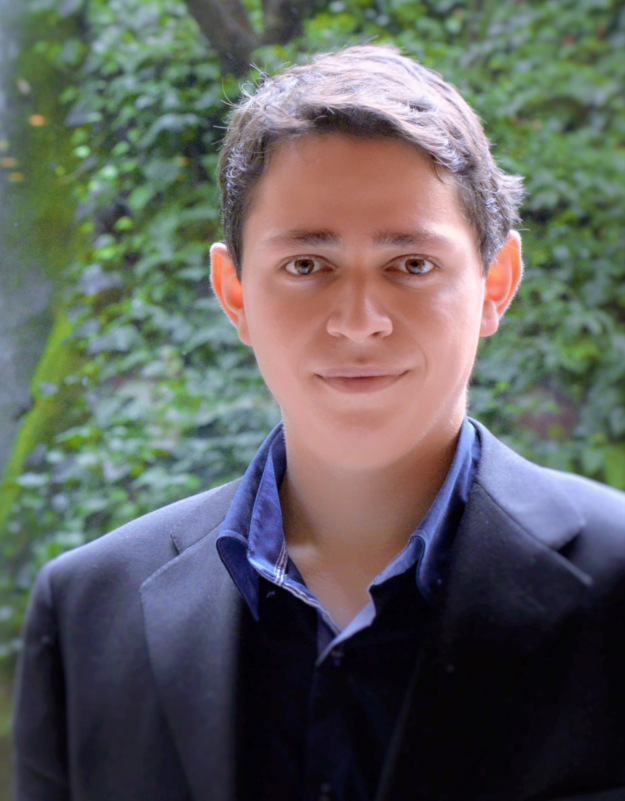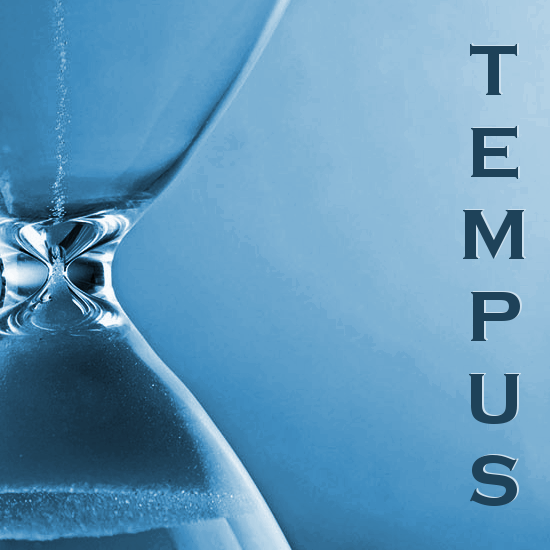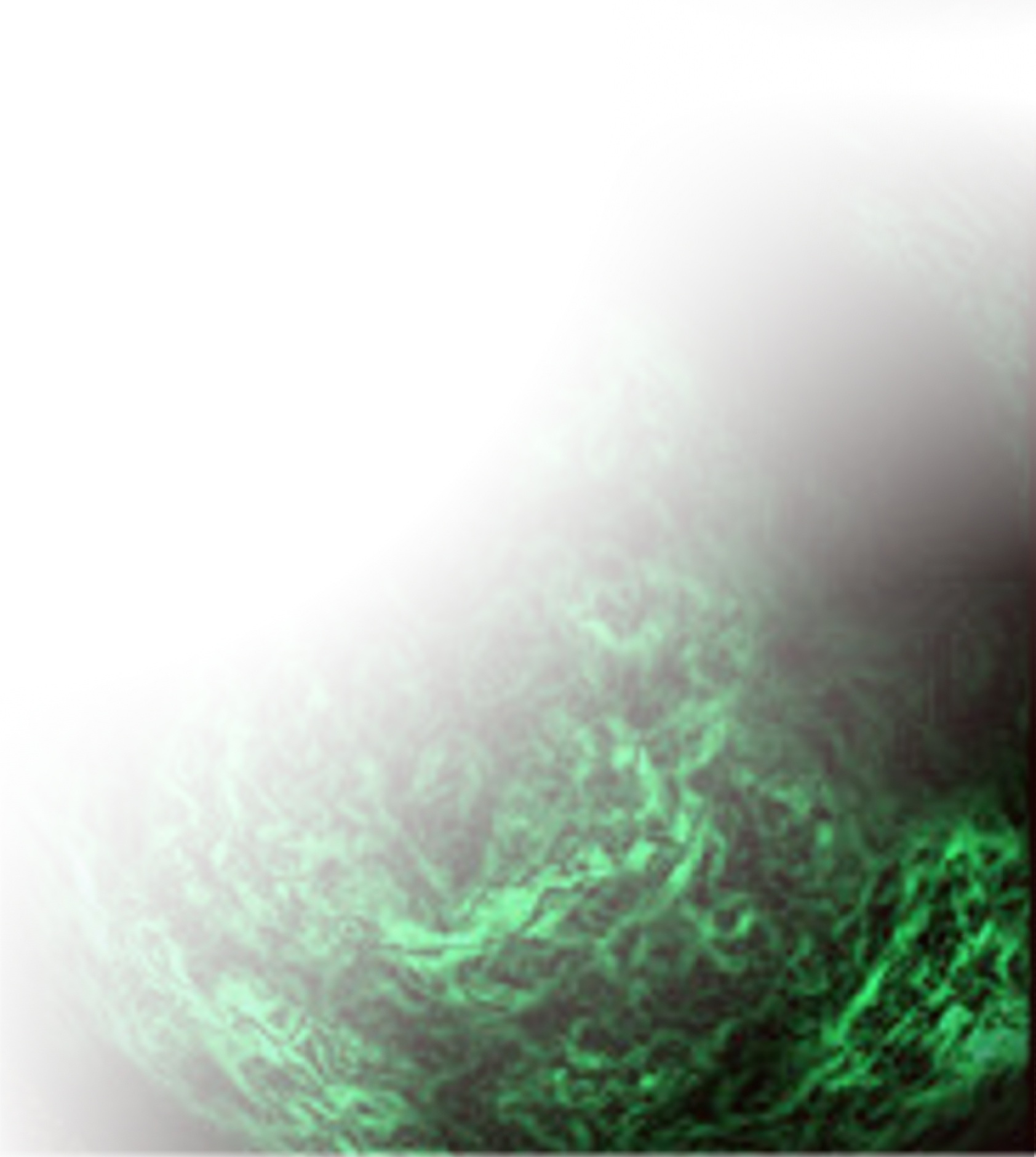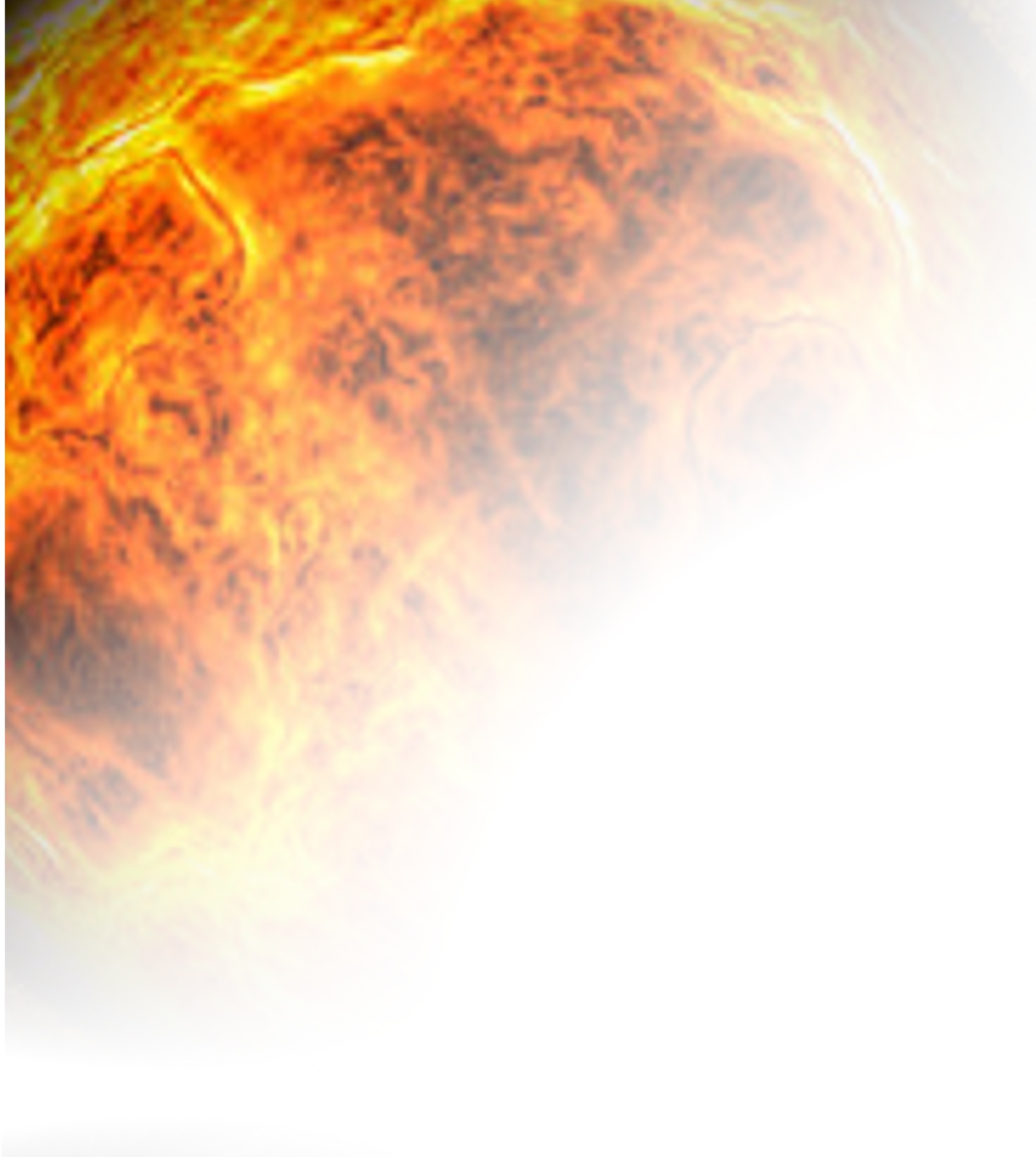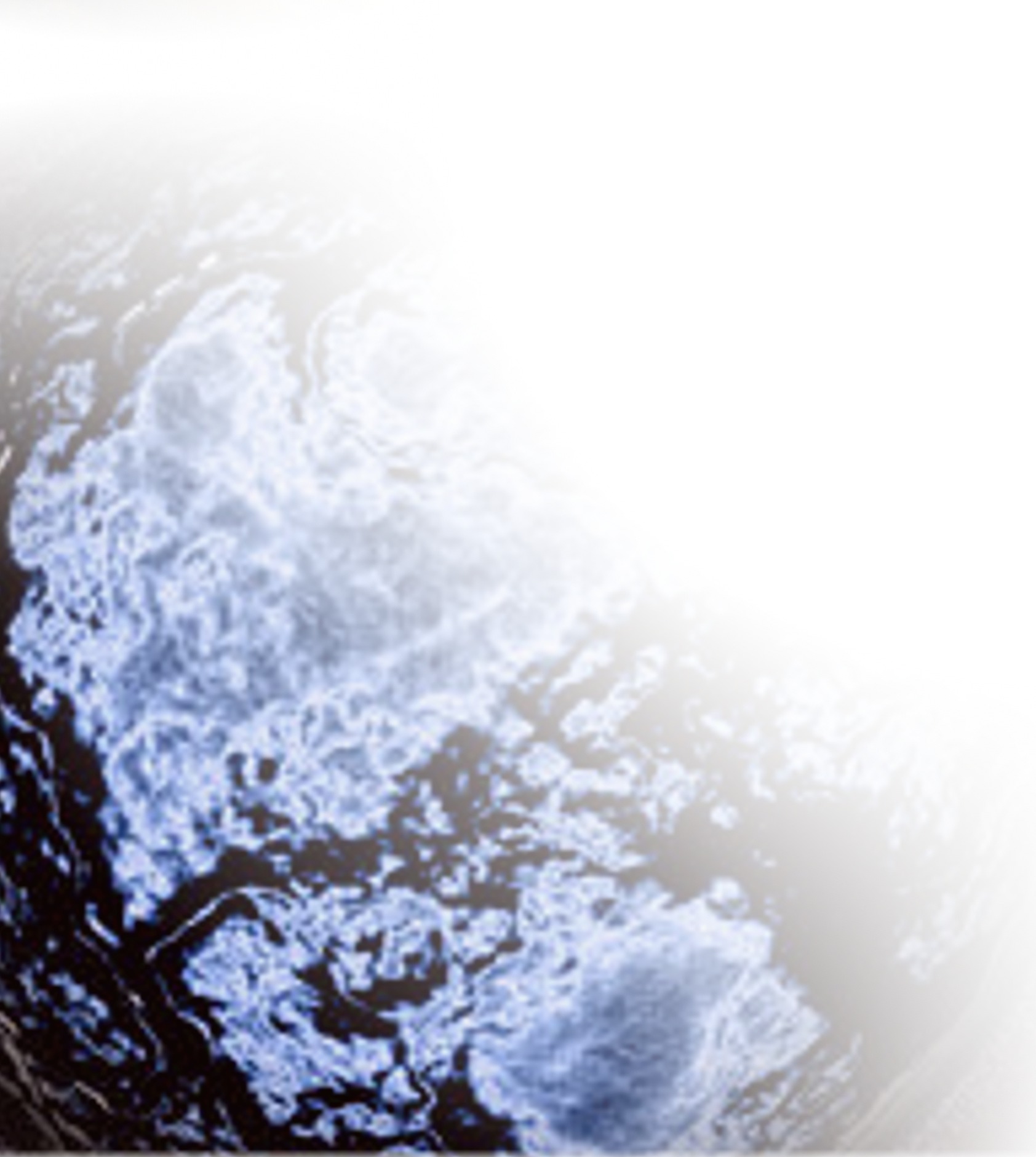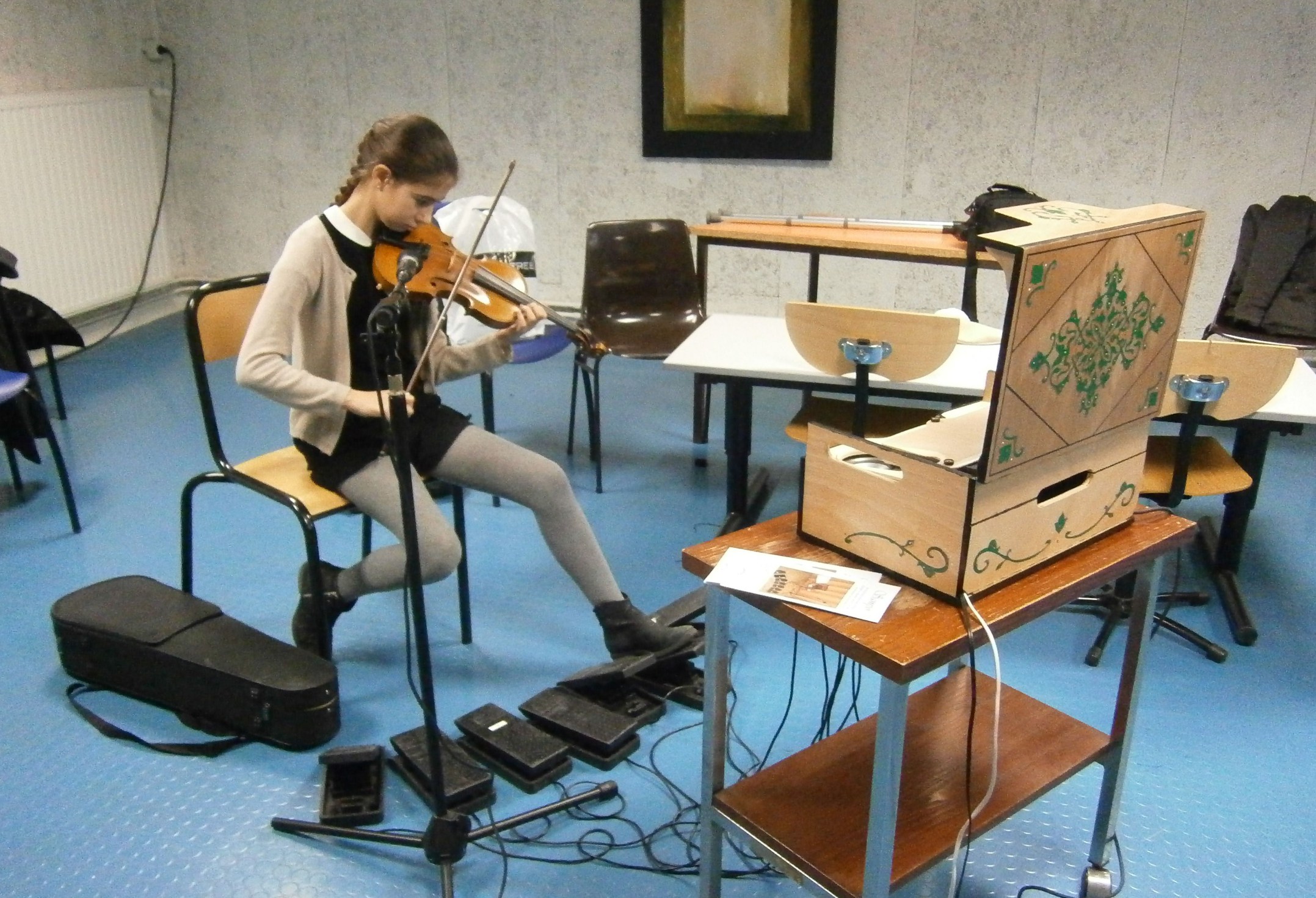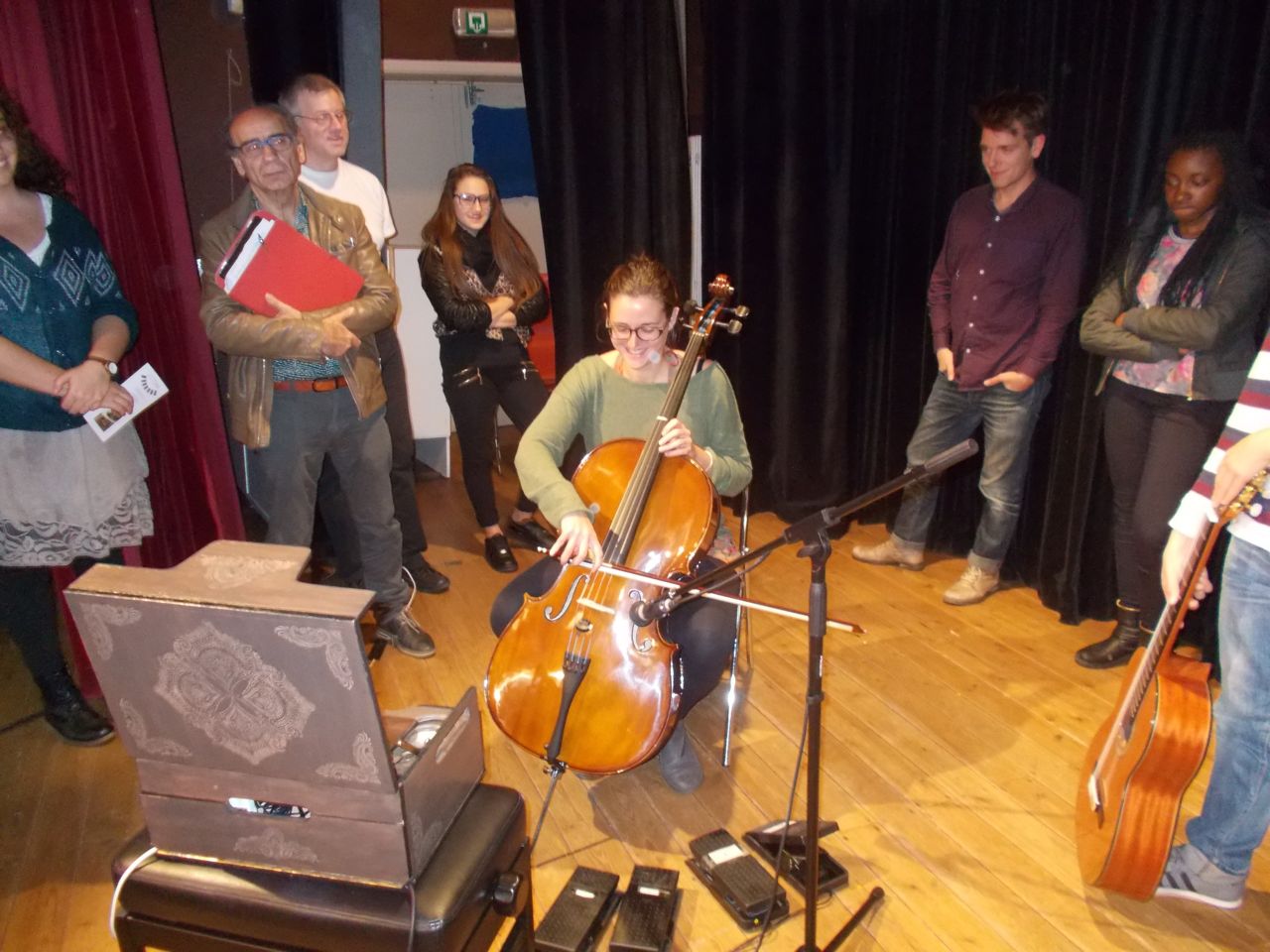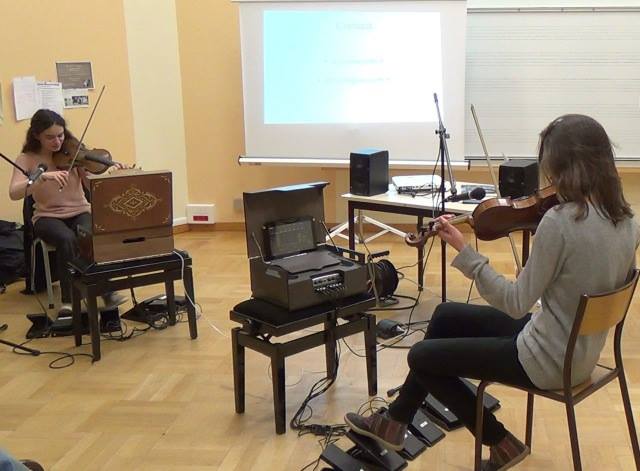He studied at LEMS-SPACE (Pesaro, Italy) and at CMT (Helsinki, Finland), currently he prepares a Master in Media Art and Design at Bauhaus-University of Weimar (Germany).
He is interested in sound, its perception and how it relates with other media, exploring sound phenomena of elementary sound entities and its behaviors. He is inspired by the beauty of physics.
Sandro L'Abbate (Italy)
Sandro L'Abbate, class 1988. Graduated in photography at Fine Arts Academy in Italy. He is interested in audiovisual production, using interactive and electronics systems to observe physical phenomena. He is currently facing the sea.
Studio N.1
A disoriented individual interacts with a virtual space. The body becomes an instrument, therefore able to respond to stimuli according to a specific sound logic. As any computer program, it is a system where the defects, bugs, disruptions and any kind of interferences, lead to a fragmented pace of the narrative itself.
This work was born with the intention of creating a connection between what we see and what we hear, it's a study about connections and interactions of these processes. The simple sound material, sine waves and glitches, presents complex internal movements based on beats phenomenon linked to the dynamics of the video.
Massimo Avantaggiato is an Italian sound engineer and composer.
Since his mid-teens he has concentrated on expanding his musical landscape using electronics, unusual recording techniques and computer-based technology, all of which help him to develop his idea of sound and composition. He took a degree in Electroacoustic Composition with full marks at “Giuseppe Verdi” Conservatoire in Milan and a degree as a Sound Engineer (Regione Lombardia).
He has recently participated in: TIES2016, Toronto, Canada; NYCEMF 2016 (New York, USA), Soundthought 2016 (Glasgow); International Computer Music Conference 2014, Athens, Greece; Csound Conference 2015, Saint Petersburg, Russia; LINUX Audio Conference 2015, Mainz, Germany;
Giordano National Composition Contest 2014 (finalist), Conservatorio di Foggia, Italy; CIM14 Conference on Interdisciplinary Musicology, Berlin, Germany; CIM2014, Conservatorio S. Cecilia, Rome (Italy); ATMM 2014, Ankara, Turkey; ICMPC-APSCOM2014, Seoul, South Korea.
Atlas of uncertainty
Atlas of uncertainty is a concrete music piece.
A microcosm of sounds becomes the hyletic universe explored through various techniques in this piece.
Heterogeneous sound materials are used:
- Kitchen noises;
- treated bells texture;
- electronic whips sounds;
- chimes;
- Tibetan bowls;
- noisy whooshes;
just to name a few. The sounds are here combined in well-identifiable electronic gestures.
Manuella Blackburn is an electroacoustic music composer who specializes in acousmatic music creation. She has also composed for instruments and electronics, laptop ensemble improvisations, and music for dance. She studied Music at The University of Manchester followed by a Masters in Electroacoustic Composition. She became a member of Manchester Theatre in Sound (MANTIS) in 2006 and completed a PhD at The University of Manchester with Ricardo Climent in 2010. Manuella Blackburn has worked in residence in the studios of EMPAC (Experimental Media and Performing Art Centre, New York) Miso Music (Lisbon, Portugal), EMS (Stockholm, Sweden), Atlantic Centre for the Arts (Florida, USA), and Kunitachi College of Music (Tokyo, Japan). Her music has been performed at concerts, festivals, conferences and gallery exhibitions. She is currently Senior Lecturer in Music at Liverpool Hope University.
Ice Breaker
When ice is placed into a glass of water it cracks and pops due to the phenomenon known as differential expansion. Because the water is warmer than the ice, the outer layer of the ice expands and fractures while the core stays cool. This micro-scale cracking was captured with tiny microphones inserted into tall drinks glasses and provided the concept for this composition. Additional sounds of effervescence, bubbling and pouring liquids were recorded to accompany the smaller ice sounds. This work follows on from my earlier works – Switched on (2011) and Time will tell (2013) that both explore the use of small sounds within an acousmatic context. New techniques for clustering small ice sounds were explored in this work along with Horacio Vaggione’s concept of micromontage.
Sergio Blardony was born in Madrid in 1965. He studies composition with R. J. de Vittorio and –for four years- with J. L. de Delás at the Alcalá de Henares University. He has also attended both composition and analysis courses with Heinz-Klaus Metzger, Rainer Riehn, Helmut Lachenmann, Enrico Fubini, Luis de Pablo, etc.
He has been awarded various prizes, such as the Spanish Authors Society (SGAE) Composition, International City of Tarragona Award for Musical Composition, or Joaquín Turina Prize.
He has composed over 70 works for all manner of instruments and voice: solo and chamber music, ensemble, orchestral, vocal and choral, electroacoustic and multimedia, music-theater…, played in different countries –Austria, Russia, Germany, Spain, France, Portugal, USA, Canada, Corea, China, Ethiopia, Mexico, Argentina…
Publishers: Bèrben Edizioni Musicali, Pygmalion, EMEC-Spanish Editor of Contemporary Music, Periferia Sheet Music, Babel Scores...).
Current publisher: UME, Music Sales Group.
Tracto
Element topic: AIR
Electronic and video art piece that explores the inside of a bass saxophone by endoscopy. The work is scheduled at festivals around the world. Awarded at the Shut Up And Listen (Vienna) and Special Mention in the MADATAC 04 (Madrid) festival.
"Tracto" is the image of an inert place, which when touched, it becomes an organic center, a confluence of the dry and the moist, the perfect and the throbbing, the calculated and the unpredictable. It is a journey through an interior preserved, the path through the dark cave whose holes arises air, breathing, halite and noise. (Pilar Martín Gila, poet)
Authors: Sergio Blardony, Marta Azparren
Sounds recorded from a bass saxophone Selmer Serie II, Andrés Gomis (saxophonist).
Francesco Bossi is a composer and sound designer whose work includes acoustic and electroacoustic music, video and multimedia installation. He holds degree from the Conservatorio di Milano where he graduated with highest honours in Electronic Music. His research is currently focused on the production of algorithmic/computer based custom synthesizers. His effort is to share contemporary music beyond academic audiences. His works are performed by orchestras, and selected by international festivals and concerts. His video “Urban Landscape Fractures - Milano” has been chosen by the XII Festival Internacional de Arte Sonoro y Música Electroacústica (Valencia - Spain, 2015), by SEAMUS 2016 National Conference, (Statesboro, GA - Usa, 2016), by the New York City Electroacustic Music Festival (New York, Usa, June 2016) and by the 12th CMMRInternational Symposium (São Paulo, Brazil, July 2016).
Urban Landscape Fractures - Milano
Urban Landscape - Fractures, Milano points out the urban landscape seen through fractures and discrete spaces, by dilating and shorting time and space, and even occupy them with phenomena that seem we had seen before only in the virtual.
Through these crevices is visible the city populated by buildings and structures that seem to be generated by a morphogenetic algorithm. This phenomenology overcome the boundary between real and virtual, and get the Hybrid from the two categories. The Urban Landscape is generated by a morphogenetic algorithm.
The work is affected by the Marko Kovač theory of Transvergens, by the Michel Focault concept of Heterotopia and by the Marc Augé theory of “non-place".
Born in 1979 in Palermo (Italy), Marco Busetta finishes his studies in Engineering and Piano in his birth town. After that he lives in Montpellier, Liège and Bologna.
Acqua esagonale
Recent findings (source: http://journals.aps.org/prl/abstract/10.1103/PhysRevLett.116.167802) have shown the possibility for water molecules to set up in a form never seen to this day, where the hydrogen and oxygen atoms are placed at the same time in all the six equal positions. The conditions for this state to appear have been found in a channel 5 angströms large in a beryllium mineral.
For the pièce Acqua esagonale we used the atomic mass of Beryllium (9,01218 u) to generate a series of sounds distinct from the element, and its electronic configuration for the presentation and the symbolic description of the intra atomic “world” of the element. The hexagonal structure reappears in two different forms, either in the layout of the beryllium series, or in the adaptation of the series which generates the “pattern” of the water. Anyway, the number six is the building block of the whole piece.
Among the awards bestowed the National Award Sonic Visions are - Yamaha 2007, The third prize at Rossana Maggia Luigi Russolo Competition 2011, Honorable Mention in the First Latin American Competition Becerra G. Smith, as well as support to complement various artistic projects.
He has presented his work at festivals like the International Forum of New Music Manuel Enriquez in the years 2010, 11, 12 and 13; EMU International Electroacoustic Music Fest Santa Cecilia Conservatory in Italy in 2009, 10 and 11; NYCEMF 2013 - The New York City Electroacoustic
Music Festival; The International Workshop on Computer Music and Audio Technology Taiwan - WOCMAT 2010 and 2012; Electroacoustic Spring Festival of Valencia, Spain. 2010; Spring Festival Electroacoustic Havana, Cuba. 2010; 2aBienal Composition from the University of Cordoba, Argentina, 2012; Humanities, Arts and Technology Festival, 2010 University of North Carolina, USA and many more.
Cyhos
Each of the movements the sound composition are an universe defined with hundreds of new possibilities open to the indefinite, the transfinite as a loud explosion, like an explosion with reactors of sonic consequences whose shape is to the material an electronic sampling of the prelude to recreate the universe that exceeds the finiteness of the perfect work, that turned into a transfinite somatic sound.
The transfinite sound as an ideal work, even before their own time, before the first fugue and sonata, before the first dance and the discovery of fire. That is, superstructure and superstructure - without tempered scales, tones, or finite form - for its massive energy source deterministic - probabilistic statistical universe and has the advantage over the traditional restricted - emotionally neutral musical form.
According to Heidegger's phrase:
"Let becomes visible itself as shown" (Sein und Zeit, p. 34).
MOD
In mathematics the result of the modulus operation is the remainder of a euclidean division. For this work, is an added value and a sedition that achieves the unique combination between the perception of the abstract image and the reception.
Raised in Hong Kong, composer Chin Ting (Patrick) CHAN is Assistant Professor of Music Theory and Composition at Ball State University. His music has been featured throughout the North and South Americas, Europe and Asia; at festivals such as the International Computer Music Conference, the International Rostrum of Composers, IRCAM’s ManiFeste, the ISCM World Music Days Festival, June in Buffalo, the Mise-en music festival and the Wellesley Composers Conference, among many others.
Zone 23
Zone 23 is my sonic representation and metaphor of a place at war. The piece uses sarcasm against science when it is not used properly (e.g., mass destruction). The piece begins with a resonant chord, which often comes back throughout in order to connect the different sections together. The piece features mostly sounds that pertain to the idea of modern war - for example, sounds of helicopter, gunfire, bombs among others. The middle section features the juxtapositions of animal and bullet sounds, with a person steadily stepping in the background. It can be interpreted as the person witnessing a war from a distant, as if he/she is not involved or affected.
Christopher Coleman (b. 1958, Atlanta, GA) composer, conductor, trombonist, is currently Composition Coordinator and Associate Head of the Hong Kong Baptist University Department of Music, where he has taught for the past 26 years.
Coleman's works range from orchestral tone poems to large-scale multimedia/improvisation pieces, to works for symphonic band, chamber ensembles, instrumental solo, and voice. A prize-winning composer, he has received numerous commissions and grants, including those from from local groups the Hong Kong Wind Kamerata, the Hong Kong Wind Philharmonia, the Hong Kong Composers' Guild, RTHK Radio 4, and the Hong Kong University Grants Committee.
His music is published by Vanderbilt Music, Maecenas Music, Theodore Presser, Ensemble Publications, C. Alan Publications and Crown Music Press.
A trans-media artist, Christopher Coleman also works in painting, sculpture and computer graphics.
Greater Than
"Greater Than" is a gradual transformation from one sound object to a contrasting one. There are only three simple sound sources used: a temple bell, a harpsichord, and a marimba. The sources are treated to replication hundreds, thousands, even millions of times; so like atoms create elements which create molecules, the musical 'atoms' create these larger objects. The whole, then, being greater than the sum of the parts.
Gerardo De Pasquale, composer, researcher, sound designer, visual designer; studied music specializing in violin with Georg Mönch and composition with Edoardo Ogando in Rome. Since 1995 works on an aesthetic language of composition concrete-spectral, and sound quality and visual synesthetic.
Some of his compositions are documented in important exhibitions and museums including: Bauhaus-Archiv Berlin, Städtische Galerie im Lenbachhaus of Monaco, the Museo Cantonale d'Arte in Lugano, Exposition Internationale d'Art Contemporain - Jeune Création, Grande Halle de la Villette Paris, Archives DOCVA Milan, MAXXI in Rome, Galleria Milano.
Latest work the CD “Mosconi-Wagner” for the label Alga Marghen, produced with Gabriele Bonomo, Realizing composition, mixing, sound engineering, technical realization and graphics.
SGUARDO SOSPESO - RIFRAZIONI
The composition (concrete) describes a suspended dialogue between earth and sky. Listening is a crossing, as an echo (the myth of Echo and Narcissus), to go to the farthest point to become pure abstraction.
The audio material used are 4 day and night audio recordings made in the countryside and in the city center, 4 spatial audio recordings, remote increasing, the planet Earth (NASA samples), plus 6 NASA samples (sonification of light curves) of the Kepler project: KIC9812351B, KIC12268220C, KIC3866709B, KIC5775232B, KIC7671081B, KIC9700322B, KIC10273384B.
The video consists of a sequence of 8 images of the celestial time, in increasing depth in space. To changing the scale and depth occur, each time, other celestial bodies, until the image blends into an abstract plot that shows current limits of observational instruments, the boundary of the knowable.
Tony Doyle is an Irish composer/academic based in the UK. He studied classical and jazz music performance and composition. Completed studies include a Masters in music and media technology at Trinity College Dublin and a PhD at the University of Limerick in Spatial Audio. Upon completion of his doctoral research he was employed at the University of York to work on an EPSRC funded project for spatial audio for domestic interactive entertainment.
Doyle has performed new compositions for piano and ensemble, including spatial compositions, in Ireland, the UK, Holland, Chicago and Japan. He has also worked with Ensemble Modern in Japan (Funded by Culture Ireland) and the ConTempo String Quartet.
SPS Etude 5.1
This work is an excerpt of an Octophonic arrangement down-mixed to 5.1 This work was composed as part of my PhD which developed an spatial application to influence the perceptual impression of the spatial characteristics of a source. This piece is based on work developed over the course of the research that investigated time-frequency-spatio presentation.
The method is known as Spectral Precedence Spatialisation (SPS) that is capable of allowing control over the volumetric imaging of a source using phantom placement with amplitude panning. Using a 2D array allows for distance, proximity, apparent source width, envelopment and vertical effects, while 3D arrays allow for volumetric imaging with height information and depth (front to back) imaging of a source.
Gino FAVOTTI, 1962, France. Self-educated musician (bass and violin), I studied electroacoustic composition at the INA-GRM-ADAC with J. Lejeune and P. Mion, then with J. Schwartz at the ENM in Gennevilliers. In 1990 I became assistant to composer L. Ferrari at the Muse en Circuit studio. I compose electroacoustic and acousmatic works for tape and in multiphonia.
I collaborate and exchange with other composers and groups and create music for live performances and visual arts.
I produce and compose musical performances: “Arbors”, on fundamental scientific research transposed in the field of arts. I teach electroacoustic composition since 1993 at G. Bizer Conservatory in Paris’ 20th district where I have founded and developed the class of electroacoustic composition.
Issus de l'évolution
“Issus de l’évolution” is one of the movements of the project Arbor II on Charles Darwin’s evolution theory. Arbor II was created at the occasion of a commission from the Museum of Natural History of Paris for C. Darwin’s bicentenary. This so far two-part project aims to connect contemporary evolutionary scientific approaches and their interpretation or transposition in a musical, poetic and imaged form. In its complete concert format, this project is a construction with a filmed researcher explaining a theory or a hypothesis, connecting it to fundamental research. This is transposed in a poetic framework by a poet on stage and in a musical framework with surround or multiphonic electroacoustic compositions. This movement, “Issus de l’évolution”, deals with phylogeny in science of evolution.
Rob has a passionate interest in how sound behaves acoustically and has developed many techniques for controlling and building virtual spaces.
He is part of a collaborative team with Simeon Nelson and Nick Rothwell creating installation works combining sound and light sculpture. Plenum is a computer generated real-time architectural sound and light projection shown on many of the world’s most iconic buildings throughout Europe and Australia. 2016 will see Rob working on Simeon’s new Wellcome Trust funded project Cosmoscope.
In collaboration with Kate Romano and the Guildhall School of Music and Drama, Ritual is a new ACE, RVW Trust and Britten-Pears Foundation funded a concert tour that includes Rob’s new realization and performance of Poeme Electronique by Varese, and his new composition - Faraday Waves - a companion piece for the Varese to be premiered at the 2016 Cheltenham Festival.
Faraday Waves
Faraday Waves is a short audio-visual work written as a companion piece for a concert-hall performance of Poème électronique by Varese.
Faraday discovered that a liquid undergoing vertical vibration, whose frequency exceeds a certain value, becomes unstable to surface waves. Also known as Faraday Instability, they form non-linear standing waves that appear on liquids enclosed by a vibrating vessel.
Thanks to an award from Santander, Rob was able to visit his colleague Professor Stephen Morris at the Physics Department, University of Toronto, May 2015. Part of Stephen’s research regards ‘shaking things’ and sound is often used as a form of stimuli. The visualization, created by Sam Jury, uses video documentation of the classic physics experiment invented by Faraday.
Faraday Waves uses speech rhythms found in the E.E. Cummings poem I Carry Your Heart With Me. Placed within the resonance of a bell, it symbolises the creation and birth of a new life.
Reuben Jelleyman (1993), currently based in Wellington, New Zealand, is a graduate in physics from the University of Victoria, with additional studies in sonic art at the New Zealand School of Music. His music stretches between contemporary aesthetics and historic practices, and focuses on construction. Recent works include a chamber opera, works for orchestra, soloists, and multichannel environments.
The composer has had music played by Avanti! (Finland), Intrepid Music (Akl), the NZSO, NZTrio, and ACL (Singapore).
In 2015 Jelleyman was placed as a finalist for the SOUNZ Contemporary Award, placed first in the NZSM Composers Competition and co-winner of the inaugural NZTrio Composing Competition and the NZSO Young Composer Award.
Nucleosynthesis
Physicists believe that the first nucleosynthesis occurred approximately 3mins after the big bang*.
* Thornton and Rex, Modern Physics; Third Edition, pg. 574, Thomson Brooks/Cole 2006, ISBN 0-495-12514.
Kokoras's sound compositions use timbre as the main element of form. His concept of "holophony" describes his goal that each independent sound (phonos), contributes equally into the synthesis of the total (holos). In both instrumental and electroacoustic writing, his music calls upon a "virtuosity of sound," emphasizing the precise production of variable sound possibilities and the correct distinction between one timbre and another to convey the musical ideas and structure of the piece. His compositional output is also informed by musical research in Music Information Retrieval compositional strategies, Extended techniques, Tactile sound, Augmented reality, Robotics, Spatial Sound, Synesthesia.
Mnemonic Generator
Mnemonic Generator for electroacoustic sounds was composed during summer 2011. The piece creates a surreal soundscape of an ancient construction site. Like a time machine the tribal soundscape slowly is evolving into a heavy industrial delirium. The reality is amplified and the concrete sound is transformed into an abstract sound object. Complex rhythms introduce archaic soundscapes with powerful gestures. Ecological patterns determine the compositional structure and become resources for further development.
The music of Phivos-Angelos Kollias has an anthropocentric approach; the listener becomes the central focal point, invited to participate actively with his/her perception. As a composer-researcher, he is exploring the connection of music and the interdisciplinary scientific studies of complexity theories applying them to his music. Kollias was born in Rhodes, Greece, and he has studied composition in England and France with the support of four foundations. He has received 7 awards and 8 nominations for his music in several international competitions and another 5 collaborative international awards. His works have been performed in more than 20 countries in more than 70 concerts. He has studied composition with H. Vaggione, J. L. Hervé, Y. Maresz, J. M. López López, R. Hoadley and R. Samuel. He has taken master classes from H. Lachenmann, G. Aperghis, B. Furrer, T. Murail, P. Ablinger, P. Hurel, M. Lanza, U. Chin, O. Strasnoy, A. Hölszky, C. Gadenstätter, L. Naón and A. Di Scipio.
And if...
And if… is the third part of my triptych of music works based on feedback; feedback as a sound; feedback as a principle of composition.
An algorithm, or a genetic code, gives birth to a music organism, that I call an “Ephemeron”.
For this work, Ephemeron’s algorithm is planted through the internet on another computer; a computer being on another place and another city.
A listener is there.
A music organism is born to this other space; the listener is listening and reacting
and by reacting, is acting upon the organism.
A conversation is established through the internet;
the music organism communicates with the listener who is reacting spontaneously to the sound.
The conversation is recorded, cut, reworked, re-composed
this is the fruit of this re-composed conversation.
Born in Athens in 1966. Having originally studied engineering, he obtains a diploma in composition at the Conservatory of Strasbourg in Ivan Fedele’s class, at First prize in Musical Acoustics at CNSMDP with Michèle Castellengo, and takes the ATIAM (Acoustics, signal Treatment, Informatics, Applied to Music) course at Ircam. Among his major works played mainly in France and Europe, « L’avenir du silence » for an actress, a saxophonist, a percussionist, electronics and real-time video was recently premiered at the Amphithéâtre de l’Espace Landowski in Boulogne-Billancourt. Artistic Director of the Syntono Association, Nikos Koutrovidis launches Synoork in 2013, a project for a computer orchestra which associates pedagogy to musical creation and whose third edition started in January 2016 in Boulogne-Billancourt. He currently works on Ubique, a co-creation for cello, saxophones and a computer orchestra in the framework of Synoork 2016.
Des Airs, des Eaux et des Lieux
(Περὶ ἀέρων, ὑδάτων, τόπων)
The title borrowed from Hippocrates’s text with the same name, “Des Airs, des Eaux et des Lieux” is a work that depicts elements of the nature in a musical chronicle.
The sound materials of the piece are all obtained from computer-generated syntheses which use as their raw material white filtered noise.
The idea of using synthesis in stead of recordings has the dual objective of, on the one hand, the experimentation and the comprehension of the physical mechanisms of these natural elements, and on the other hand, the liberation of creativity compared to the constraints of a sound recording. The sound result of this “meta-acousmatic” process is not intended to make a the truthful simulation of nature, but to use these acoustic models as a source of inspiration for composing the musical work.
Joungmin Lee’s music has been performed in the US, Europe and Asia. Lee's music will be published by ABLAZE Records and Editro Sconfinarte, which will include his award-winning work ‘Vexatious’ for string quartet. In addition, his electro-acoustic piece ‘Heterogeneous’ has been selected for ABLAZE Records Electronic Masters Vol. 5 disc. Lee's work has been recognized by numerous competitions and “Call for Scores”, including Salvatore Martirano Memorial Composition Award, the Hong Kong New Music Ensemble Live from Prague project, the Florence String Quartet Competition, Chang-Ak Contemporary Music Society Composition Competition, Valencia International Performance Academy & Festival, SIME International Electroacoustic Music Competition, Cicada Consort, and National Student Electronic Music Event, among many others. Currently he is pursuing the Ph.D in composition at the University of Iowa, and he holds degrees from New York University (M.Mus).
3 sounds
It is a cliché to say one’s daily routine and items can, together or separately, be a source of inspiration. Clichés can sometimes prove to be right. My two-year-old twins are always alert and curious. Recently, they found the way a spring door stopper makes a sound and repeatedly pushed the door. I kinds of liked the way it sounded. There is a small clock on my desk at home. It ticks very quietly, to the point of noticeability. The pitch darkness and silence of the night can slightly augment the ticking sound of the small clock. I liked the way it made me feel. I have an acoustic guitar which works OK, if not very well. I often strummed it. I don’t own a violin but have a bow. I used it to play my guitar. It created something of sul ponti cello, which was beautiful. I brought together my boys’ acoustic curiosity, my clock’s relative calmness and my guitar’s crossover to create an electric music piece set to soak us in a combination of the three inspirations.
Heterogeneous
This piece is an expression of the duality of human beings, torn between desire and solitude. The bigger the desire becomes, the tougher the solitary confinement of our minds becomes. The marble in a glass plate and a large closed door in the piece represent desire and solitude respectively. The marble slowly rolls towards the desire. It rolls faster and faster--and louder and louder--but cannot depart from the confines of the plate. The marble stands before solitude. When solitude vanishes, the marble rolls again. The closed door is human solitude. The door is attempted to be prized open but remains shut still. It is pushed against more strongly, to the point of being dented. The door groans in pain. It still remains shut as if being full from within. It defies any entrant. The marble and the door are unified in their isolation. Self-confined space is sad.
Born 1937 Miranda (Spain).
Musical studies with Vladimir Ussachevsky, Mario Davidovsky and Edgar Varese at Columbia University, New York, USA, studied engineering at Barcelona Polytechnic and Columbia University, New York, USA. Teaching Assistant at Columbia Princeton Electronic Music Center New York, USA (1962/5). Founding member of the Phonos Electronic Music Studio in Barcelona 1974 and its secretary since its establishment (Phonos Foundation). Coorganizer of ICMC 2005 and SMC 2010. Lecturer for History of Electroacoustic Music at Barcelona Escola Superior de Musica and Pompeu Fabra University
His musical output is mainly electroacoustic, having composed many works in combination with live instruments.
Cordes (The Cocktail Party Effect)
The cocktail party effect is the phenomenon of being able to focus one's auditory attention on a particular stimulus while filtering out a range of other stimuli, much the same way that a partygoer can focus on a single conversation in a noisy room. For a few years I have been experiencing with fine filtering processes on diverse types of samples. In this case I applied it on a the tuning of a string ensemble. Distributed in 6 channels phenomena pop up, surprisingly: listen with attention, even voices come up.
Van Der Linde is a painter, composer and multi-media artist working professionally since 1976.
Glass Frequencies Geometry
This work combines the element of metal with water through crystal. We can observe the different geometrical patterns that form because of friction on the rim of the glass.
The video only serves as a visual support to make the spectator understand that the sound source is real and in real-time.
Stanislav Makovsky is a composer born in 1988 in Yourga (occidental Siberia), Russia. After his studies at the Tchaikovsky Conservatory of Moscow where he studied with Yuri Kasparov, he enters the CNSMDP in Stefano Gervasoni’s and Luis Naon’s classes (new technologies).
His works have been played by ensembles such as Ensemble Multilatérale, Recherche, Neue Vocalsolisten Stuttgardt, GAM-Ensemble, MolOt Ensemble, the Studio for New Music, MCME and others.
He participated in the festival Monaco électroacoustique (2015), Journées européennes de la musique électroacoustique in Chalon-sur-Saône (2015).
Winner of the “Prix St Christophe”, Paris, France (2016), "Peer Raben Music Award" Cologne, Germany (2015), "Prix Macari Lepeuve", Paris, France (2015), «Best sound» in the festival ZubrOFFka , Bialystok, Poland (2015), «Première exécution à Saint-Pétersbourg», Saint-Petersburg, Russia (2011).
Artist in residence of the Robert Laurent-Vibert Foundation in Chateau de Lourmarin, France (2014-2015).
Sintro
The music that introduces the sounds, the space and the musical objects. We are walking through sound waves, hearing the beat of the whole universe...
Benjamin O’Brien composes, researches, and performs acoustic and electro-acoustic music that focuses on music similarity, translation, and machine listening. He holds degrees in music composition and mathematics from the University of Florida (PhD), Mills College (MA), and the University of Virginia (BA). His compositions and research have been presented at conferences and festivals throughout the Americas, Europe, and Asia, including ICMC (2011-13, 2015), Journées d’Informatique Musicale (FR), Art of Record Production Conference (DK), and Signal Festival (CZ). Some of his honors include the Music OMI Fellowship (OMI International Arts Center), Phil Winsor Electroacoustic Music Young Composers Awards Finalist (Workshop on Computer Music and Audio Technology), and International Audio Artist Finalist (Radical dB Festival). His work is published by Oxford University Press, SEAMUS, Canadian Electroacoustic Community, and Taukay Edizioni Musicali. He currently lives in France in Marseille.
Along the eaves
"Along the eaves" is part of a series that focuses on my interest in translational procedures and machine listening. It takes its name from the following line in Franz Kafka's "A Crossbreed [A Sport]" (1931, trans. 1933): "On the moonlight nights its favorite promenade is along the eaves." To compose the work, I developed custom software written in the programming languages of C and SuperCollider. I used these programs in different ways to process and sequence my source materials, which, in this case, included audio recordings of water, babies, and string instruments. Like for the other works in the series, I am interested in fabricating sonic regions of coincidence, where my coordinated mix of carefully selected sounds suggests relationships between the sounds and the illusions they foster.
João Pedro Oliveira (born 1959) studied organ, composition and architecture in Lisbon. Ph.D. in music (composition) at the University of New York at Stony Brook. His works include a chamber opera, a Requiem, several orchestral works, three string quartets, chamber music, music for solo instrument, electroacoustic music and experimental video. A recipient of numerous national and international awards, including three awards at the Electroacoustic Music Competition in Bourges, and the prestigious Magisterium in the same competition, the Giga-Hertz Award, the first prize in Metamorphoses, etc... He is a full professor at the Federal University of Minas Gerais (Brazil) and professor at the University of Aveiro (Portugal).
Hydratos
Hydatos is a greek word that means “water”.
This piece is inspired on the first verses of the Old Testament (Genesis Chapter 1:2)
“And the Spirit of God moved upon the face of the waters.”
Michael James Olson is a Minnesota-based composer, producer, and media artist. Michael’s concert music has been performed throughout the world, including the Beijing Science Museum, SEAMUS, ICMC, EMM, EABD, Noisefloor Festival, International Saxophone Symposium, and Audiograft Festival, among others. Michael is the Director of the Root Signals Electronic Music Festival, a festival of electronic music and media art which features more than 60 composers annually, and is held at campuses across the country. Michael’s music and production has been featured on more than 25 albums and in films and television, including programs on MTV, VH1, E!, Spike, ABC, NBC, PBS, and CBS. He holds a MM from Georgia Southern University, and a Doctorate from Ball State University, where his composition teachers include John Thompson, Michael Pounds, and Keith Kothman. Michael currently serves as Assistant Professor of Music Composition and Music Technology at Minnesota State University.
Emergence
Emergence is a piece that chronicles a journey from multiple perspectives; the humanity's vision of the natural world, the human made world, and all of the versions in between. a split screen narrative juxtaposes competing strains of thought; a process that converges, diverges, and reforms into new pathways.
Paolo Pastorino (1983) is an Italian guitarist and composer.
Since 2006 he starts to work as sound engineer for some Rock, Industrial and Nu-Metal bands. He studied and graduated in computer music and sound technology at the Conservatory of Sassari (2015).
Currently he is specializing in new music technologies at the Conservatory of Cagliari.
In his works, he uses electronic instruments and algorithms realized by software, as well as electronically elaborated traditional instruments and other concrete elements that exist in nature.
So, his experience does not only regard traditional and electronic composing, but the implementation of control systems, developed on Max MSP, for live electronics and for assisted composition too.
Dimensione aggiuntiva
The basic idea of this composition is that of creating the timbre and temporal joints for each audio fragment, this is a way for me to create a timeline of events.
I tried to sculpt each sound object so as to create a lively form capable of moving in an imaginary space.
“Dimensione aggiuntiva” means an additional dimension which is generally referred to a further extension of the objects.
Through the elaboration of concrete and synthesis sounds I'm searching for new timbres that lead me to choose different compositional strategies and solutions so as to make each new composition different from the others.
Each sample was processed through some algorithms developed by me on Max / MSP.
Degree in Composition – Universidade de Aveiro (with 3 prize scholarships). PhD student (Musicology) - FSCH-UNL. Composition seminars with Emmanuel Nunes and Stockhausen. Researcher at Institute of Ethnomusicology. Artistic director of the Festival - DME (Dias de Música Electroacústica). Director of Conservatório de Música de Seia. Professor at EMNSC, Piaget Institute, Universidade Nova de Lisboa and ESART-IPCB.
Fluxus, Lift
This piece belongs to the cycle Fluxus, whose pieces are inspired by elements of physics and in which musical elements that relate to certain physical phenomena related to fluid mechanics are developed. Other pieces of this cycle are Fluxus, Dimensionless sound for flute and electronics (commissioned by Festival for the Liberation of Sound and Image, Paris, 2012), Fluxus, Transitional Flow (commissioned by Festival Primavera, Portugal, 2013), among other compositions in progress. This particular piece uses recorded sounds of aircrafts in the Aero Club of Torres Vedras and synthesis techniques used to simulate types of sounds that relate to the idea of "Lift" in a perspective of aerodynamics and music. The piece was premiered at the Festival Monaco Électroacoustique 2013.
Trained saxophonist, Jonathan Robert got interested in electroacoustic composition through his practice of free improvisation, linked to sound treatment.
His research as an acousmatic composer is to combine the power and the possibilities of electronics with the vitality of physical and instrumental breathing.
Having a diploma from CNSMDP in improvisation, instrumental theatre and pedagogy, Jonathan Robert shares his activities between instrumental practice, composition and teaching. He currently studies electroacoustic composition at the Conservatory of Pantin. His electroacoustic works have been played notably in Evreux, Le Havre, Pantin and the Lilas during the festivals Tourneson, Pied Nu and Musica Temporalia.
pHHp
pHHp is designed as a composition on the Henry model.
The sound material uses the theme of pH, its different stages and transformations. The gaseous stage of Hydrogen (dihydrogen) is central in the composition with its windy, volatile and voluble, almost vocal aspect, explored here in a purely Henryan combinatory. The wink to Pierre Henry (pH) is extended in the work with the two ways-voices of the loudspeakers (Hauts-parleurs, Hp in French).
We cannot stay neuter before the basic character of this statement, the solution of this particular pH being sometimes acid...
Aldo Rodriguez. Born in Culiacan, Sinaloa, Mexico in 1966. His life has been music and technology: Pioneer in Electroacoustic and Digital Arts in Sinaloa and the Pacific Northwest, composer and researcher, sound and visual artist. He graduated in Electroacoustic and Digital Arts by the IRCAM.
As Visual Artist has won the Northwest Biennial Visual Arts being the first composer / visual artist in Sinaloa in obtaining such distinction, as well as the XXV Biennale Hall of Plastic Sinaloa in 2012. He was selected by the Art Museum of Sinaloa and Bancomer Foundation for assembling his intangible Genetics work: hologram projection of sinaloense DNA generating its own masica in real time.
His exhibition Rendevouz12 was exhibited in France, Spain, Austria, USA. He has designed the multimedia scenography for operas.
It is considered the most important composer / visual artist of his generation and northwest of the country.
Landscape (2015)
This work - Landscape / Paisaje in Spanish is an audiovisual work that shows the way media affects how people view themselves and their world.
We live in a digital era... Many people have digital depression. This work was created using the water mouvement, a malfunction motor, jet sounds and ships arriving... all this mixture linked to a pulse... a digital pulse.
Nicolas Royer-Artuso holds diplomas in music, composition, cognitive sciences and linguistics and is currently doing a PHD in linguistics. He is a proficient musician specialized in Ottoman music and related traditions.
Tomasz Neugebauer (Canada)
Tomasz Neugebauer is an Associate Librarian, Digital Projects & Systems Development at Concordia University (Montreal, Canada). His research interests include digital research data, information visualization, bioinformatics and open source software development.
Carex Siderosticta Plastid - Photosystem II
This composition is based on musical scores generated by software we developed that maps DNA sequences into musical notation. This particular example converts genes responsible for photosynthesis found on the plastid of a carex siderosticta plant. We then had that score performed on two violins. We focused on the coding of the photosystem genes. However, the development of the software means that one could quickly convert any of the over 100 million individual sequences in GenBank into a musical score.
Demian Rudel Rey (Argentina, 1987). Composer and guitar player, he holds a diploma in guitar from the Astor Piazzolla Conservatory and from the EMBA. He completed his Barchelor in Composition at the National University of the Arts in 2014 (Argentina). He prepares a Master’s degree in Combined Artistic Languages at the NUA (Argentina, 2016).
He has received many awards including the TRINAC 2012, TRIME 2012, FINM 2012, BIENAL Bahía Blanca 2013, SADAIC 2013, conDiT 2014, TRINAC 2015, Fundación Destellos 2015, FAUNA 2015, Indie FEST Film 2016, Konex Mozart Composition Contest 2016, etc. His works have been selected for festivals in Mexico, Argentina, Great Britain, France, Chile, etc. He participated as sampling artist in Grisey’s work "Les Chants de l'Amour" at Usina del Arte (2013) and in Lachenmann’s work "Das Mädchen mit den Schwefelhölzern" at Teatro Colón (2014). Currently he is the Institutional Relations Coordinator for the Festival Bahía[in]sonora.
Céfiro
Céfiro (2015) is an experimental video with electroacoustic music. The piece suggests a moist and deep submarine environment in our minds.
Items appear and disappear in an ocean of ideas where darkness obstructs, and light seeks to guide and reveal the pleaded. Water is the main element of the piece. It is perceived in visual, musical and verbal materials (one can hear words such as rain, puddle, water in Spanish (agua)). The work tries to reflect the development process of an idea in its different stages; uncertainty, discovery, development, and eventually, creation.
Arshia Samsaminia
Born in 1989 Tehran Iran, he began Music School when he was 14.
He entered Tbilisi Music Conservatoire of Georgia and began his studies of contemporary composition with Maka Virsaladze and Eka Chabashvili (recommended Composer by K.H.Stockhausen). He has developed composition and orchestrating projects, collaborations and commissions with GEPO orchestra (UNESCO), Tbilisi Contemporary Ensemble, Omnibus Ensemble, Stockholm Saxophone Quartet, Aepex Contemporary Performance in Michigan,
attended workshops and masterclasses on subject of Contemporary Composition and Notation, Free Improvisation, Electronic music
His music has been performed in the USA, Georgia, Armenia, France, Uzbekistan, Iran.
Railroading in the East
Railroading in the East (1897-1906)
a film by : Thomas Edison
Music : Arshia Samsaminia
about music :
All sounds heard in this piece are recorded from the Tbilisi Metro in Georgia Republic, from the instant of entering the station until the moment of boarding the train, and the journey between two stations while onboard. The recordings were then sampled, processed and used as the material in the composition.
about film:
Thomas Edison was the inventor of the Kinetograph and the Kinetoscope. This silent motion picture which consists of various recordings of American steam trains throughout the country, shows Edison’s early experimentations with motion picture recording techniques.
Venezuelan composer, musicologist and clarinetist. He received a B.A. in music from the Central University of Venezuela; and a Masters degree in Latin American Musicology from the Central University of Venezuela. He has been in master classes of composition with William Bolcom, Richard Dubugnon, Alfredo Del Monaco, Diana Arismendi, Adina Izarra, Gerardo Gerulewics, Juan Francisco Sans, among others. He has won eight awards and honorable mentions in several national competitions.
Birds Etude
This piece tries to recreate a balanced environment between different birds' songs and electronic sounds that interact among them. At the end, Birds Etude blends elements of nature with sounds of present and future technology.
Ana Paola is pursuing a doctoral degree in music composition at the Schulich School of Music, McGill University. Simultaneously, she has also been experimenting at the McGill Digital Composition Studios, studying with Philippe Leroux. She is currently composer in residence for the McGill Contemporary Music Ensemble under the direction of conductor Guillaume Bourgogne. Ana Paola received her Masters degree from Rice University and her Licentiate in music composition from Trinity College London. She has been the recipient of several awards and fellowships including the Fulbright Scholarship. Her piece NEMESIS represented Mexico at the UNESCO’s 57th International Rostrum of Composers. Her piece “Fractum” is published by ALEA Publishing & Recording.
ONEIROPHRENIA
ONEIROPHRENIA is based on this serious mental disorder. A type of schizophrenia, its symptoms include deliriums and other instabilities. It is linked to the extended lack of sleep, hence causing loneliness and isolation. The music and video is divided into 3 sections: The first section leads you to experience the actual view and schizoid state of a patient with this detrimental illness. The second section encompasses a debate of certain people against forced mental illness treatment and medication, asserting that they cause more harmful mental effects to patients. The third section reflects the losing battle of the patient. The schizophrenia is strongly connected to risk of suicide attempts and completed suicides. It is believed that more than 40% of people with schizophrenia will attempt suicide at least once.
The interaction between the music and the images aids the overall atmosphere of this clinical profile.
Julian Scordato studied Composition (BA) and Electronic Music (MA) at the Venice Conservatory of Music. He specialized in Sound Art at the University of Barcelona with a thesis entitled "An introduction to IanniX graphical sequencer". Co-founding member of the Arazzi Laptop Ensemble, he has worked as a Research Assistant for the Sound and Music Processing Lab at the Padua Conservatory of Music. As an author and speaker, Scordato has participated in conferences including the recent 21st International Symposium on Electronic Art and the 1st Conference of the European Sound Studies Association, presenting results related to interactive performance systems, generative art, and feedback audio networks. His electroacoustic music and audiovisual works have been performed/exhibited in prestigious festivals and institutions in Europe, America and Asia.
Pulsion X
X is an abstract object: the unknown; the point as a generating element. X is also operation: the multiplication; the negation as a function of resistance. Through generative audiovisual processes, Pulsion X introduces the reticular form: nodes get connected to each other and the microform explodes. Globally, the chain of generated explosions describes an ever-expanding texture. Nevertheless, nodes manifest themselves in an apparent atemporality, in an actual immobility.
Timothy TAN (timbretan) often grapples with themes of complex puzzles, life with death, plus history with future predictions. He is not afraid of dark, aggressive and ironic stories. His instrumental and electronic music often has unsettling developments, as his works evoke various aversions, such as life abuses, overpowering dominance, malfunctioning personae, loss of history & human senses, as well as violence & hatred, in the hope of a silver lining, like Psaltria ignominiosa (The Disgraceful Harpist), Walkback (Persona nefanda) and Records of Pulau Ujong. Timothy also explores algorithmic elements, like in Formicae Mortuae (Dead Ants / To a Dead Ant) and Hypertuba magna; and spectralism, like in Birds Dissected for 8 speakers.
Timothy is now exploring chaotic systems as innovative, viable solutions for his upcoming electronic music, while breaking into live audiovisual performances. He is also a member of the Composers Society of Singapore.
Parasol
Parasol is about a logistic map spun on a disc, whose r value increases logarithmically from 0 to 4. While it may start as a regular pattern, chaotic patterns soon emerge for both the spinning disc and audio, albeit with occasional, perhaps unpredictable bouts of regularity. I choose the logistic map, which is arguably the simplest chaotic system discovered, and which allows us to easily appreciate the existence of chaos, alongside randomness and regularity, as a paradigm applicable to both the sciences and the arts. This parasol can also be seen as a kind of shelter that can change shape dramatically under logistic map, until the parasol itself evaporates into oblivion.
Anna Terzaroli holds a Bachelor's degree in Electronic Music from the Santa Cecilia Conservatory in Rome, where she is currently completing a Master's degree in Electronic Music. Simultaneously she studies Composition with Francesco Telli. As a composer she is dedicated to contemporary acoustic and electroacoustic music. Her musical works are selected and presented in many concerts and festivals in Italy and abroad.
Since 2009 she collaborates at the EMUfest (Electroacoustic Music Festival of Santa Cecilia Conservatory).
She is a member of the AIMI (Italian Computer Music Association ) board.
Dark Path #4
"Dark Path #4" is an acousmatic piece of electroacoustic music. The sounds used in the piece, processed, then "composed" together to create the musical work, were recorded in a soundscape dear to author, located in the Italian region of Marche. "Dark Path #4" can be defined as a journey through light, shadow, shape, color, drifts and landings.
Andy Thierauf is a Philadelphia based percussionist and composer who specializes in the creation and performance of contemporary music. He is particularly interested in combining percussion with theatre, dance, and technology.
He has appeared in Philadelphia, New York, Boston, Argentina, and across the Midwest at music festivals, conferences, and symposiums. His creative research centers on seamlessly integrating technology into performance to produce collaborative, multi-media presentations with writers, dancers, actors, choreographers, and composers. In 2016 he self-published a collection of works for solo percussion and live electronics.
Andy is half of “stb x at”, a dance/percussion duo with dancer and choreographer Sean Thomas Boyt. The ensemble has performed at various universities, art galleries, and non-traditional venues across the Midwest and East coast.
Deep Submerge Number 6
A study in the physicality of water.
Rocío Cano Valiño (Argentina, 1991). Composer and sound designer. Her work “Catarsis Sinusoidal” was selected in PAS-E (Italy, 2014), in MUSLAB 2014 (Mexico), in FILE Hypersonica 2016 (Brazil) and Phas.e 2016 (UK). Her work “El Sendero hacia lo Profundo” received The Audience Award in the Luigi Russolo Contest 2014 (France-Spain). Also, it was selected for the “Primer Encuentro de Música Contemporánea” at the National University of Arts (Argentina, 2014). During 2015 she had been commissioned an electroacoustic quadraphonic work for the festival Bahía[in]Sonora 2015. The concert was performed at the Teatro Municipal of Bahía Blanca (Argentina). This piece was selected in the 2nd International Congress on Science and Music Technology (Argentina, 2015), Zéppelin Festival 2015 (España), MUSLAB 2015 (Mexico), Sonosíntesis Internacional Festival 2016 (Mexico) and II Electroacoustic Music Festival of the Catholic University 2016 (Chile). Rocío is CEO in LINSEN Media Productions since 2013.
Catarsis Sinusoidal
A sinusoid or a poor tone in its spectrum may have transformations toward something complex and timbrically unrecognizable which generates a catharsis to return to its primitive state. These transformations are made through the processes that can be thought such as sound deformations to create others. The sinusoid is the sound element genesis. It is the simplest sound which allows conceiving more complex timbres through this essential element.
Analogous to this, there are similar situations in everyday life, which means, mood swings from the simple to the complex, from organized to chaotic and vice versa. In the piece, we can perceive how a different type of sound affects the development of the entirely elements.
Kyle Vanderburg (b. 1986) composes eclectically polystylistic music fueled by rhythmic drive and melodic infatuation. His acoustic works have found performances by ensembles such as Brave New Works, Access Contemporary Music, and Luna Nova, and his electronic works have appeared at national and international conferences including ICMC, EMUfest, SCI, CICTeM, and NYCEMF.
Kyle holds degrees from Drury University (AB), where he studied composition with Carlyle Sharpe and the University of Oklahoma (MM, DMA), where he studied with Marvin Lamb, Konstantinos Karathanasis, Roland Barrett, and Marc Jensen. He has also participated in composition masterclasses with David Maslanka, Chris Brubeck, Eric V. Hachikian, Benjamin Broening, and Daniel Roumain among others.
Reactions
Reactions is an electroacoustic miniature that takes states of matter as its inspiration by using sound sources that have a strong sense of material substance. The title refers both to the compositional process of creating cause-effect gestures by juxtaposing sounds, and the chemical reactions this process intends to mimic.
Barchelor in Conception and realisation of artistic interventions.
A diploma in fine arts and a TRANSDOC master’s degree from the [HEART] art school.
A diploma in music with Denis Dufour and Jonathan Prager.
Currently a participant in Lucie Prod’homme’s class.
On arrête pas le progrès
« On arrête pas le progrès » (You can’t stop the progress) is the second part of a piece composed in 2015 called “La force des choses”. When composing it, I sook to conjure my fears concerning the future, while trying to keep my humour.
Davide Wang is an Italian-Chinese cellist and composer, born in Bari (Italy) in 1997. He studied cello with Francesco Montaruli, electroacoustic composition with Franco Degrassi, Nicola Monopoli and Alba Battista, composition with Daniele Bravi.
He currently attends the bachelor in electronics music at Conservatory “Umberto Giordano” in Foggia.
He attended masterclasses of composers among the most important in the international scene, like Giorgio Nottoli, Michael Oliva, Mauro Lanza, Denis Dufour and Alvin Curran.
He was selected in international festivals: Art & Science Days - Music and Light 2015, Muslab 2015, Shanghai Electroascoustic Music Week 2015, Cicada Consort 2016, New York City Electroacoustic Music Festival 2016, Suoni Inauditi 2016, Concrete Timbre 2016 etc.
Sphairos
Sphairos is an acousmatic composition inspired by the Empedocle d’Agrigento’s philosophy one of the most important philosopher of ancient Greece.
Empedocle stated that the world is developed on four roots: fire, water, wind and ground. These roots are controlled by two forces, philia (love) and neikos (hatred), which allow their union and separation. When philia takes over neikos, the four roots form the Sphairos, a sphere where the 4 elements harmoniously coexist.
The piece inspired by this theory, uses as recording material the four elements, manipulated on computer using the program csound, and the sound is not attributable to the starting material.
When all the elements are put together, the Sphairos arises and life cannot exist with it.
Roberto Zanata born in Cagliari, Italy where he also graduated in Philosophy. A composer, musician and musicologist in electronic music, he studied and graduated in composition and electronic music at the Conservatory of Cagliari. In the middle of nineties Roberto became active in Italy and abroad. He wrote chamber music, music for theatre, computer music, electroacoustic and acousmatic music as well as multimedia works.
In International competitions his works have been awarded Grand Prix Internationaux de Musique Electroacoustique (Bourges), Interference Festival (Poland), Sonom Festival (Mexico) and more.
He currently teaches Electronic Music at the Conservatory of Bolzano.
START - UP
“START - UP” is the second of my audio/video work generated by a given pattern using various node data. The main intention of this work it’s focused in the possibility to use audio/video objects to implement dynamical processes to the design of a kind of living sound-imagine organism. The goal is always the intention to create an intersection between the audio object and the video object and not just a simple synchronicity.
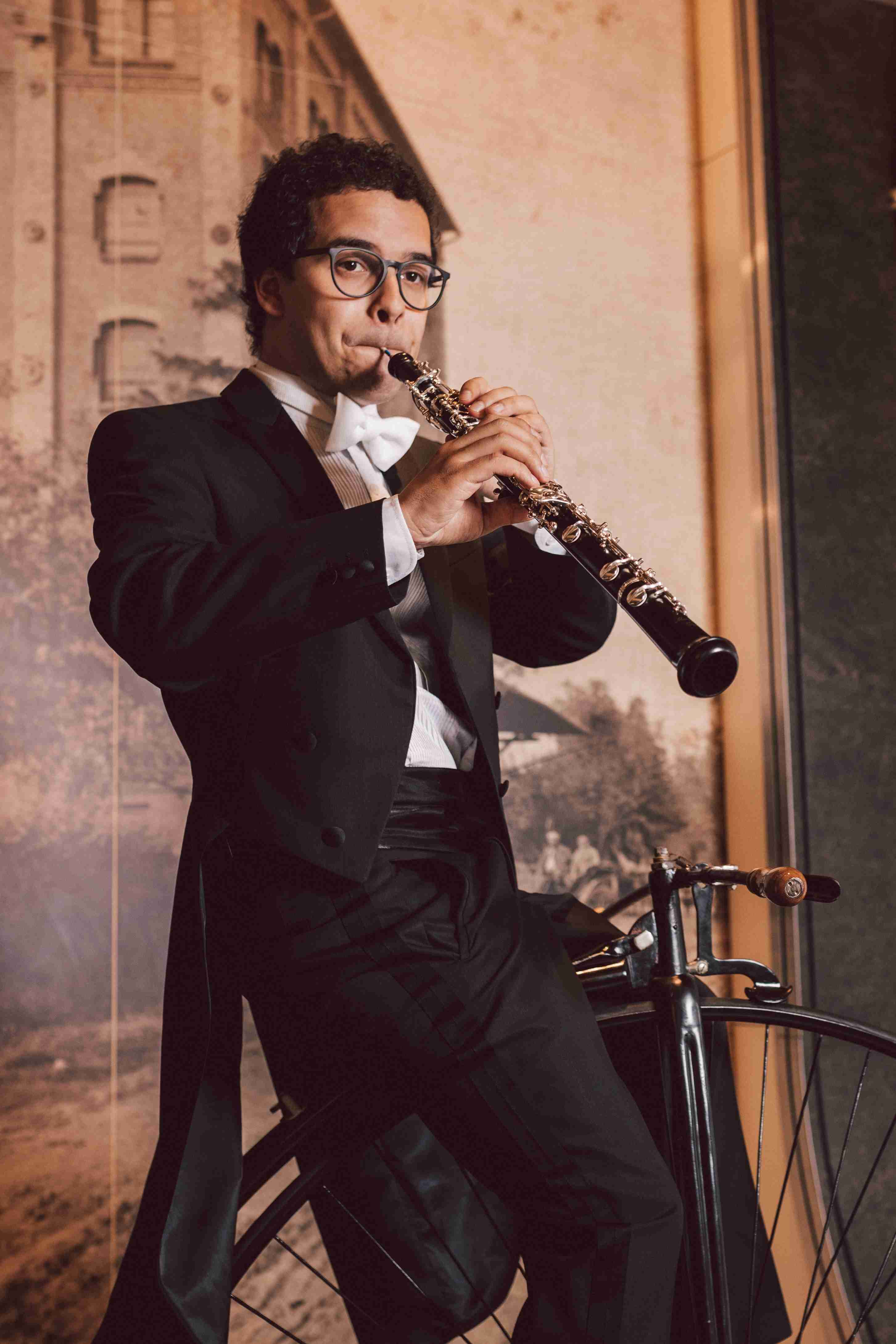 Tiago Coimbra is principal oboe in the Göttinger Symphony Orchestra, in Germany. He was member of the Gustav Mahler Jugendorchester and makes guest appearances regularly as principal oboe at the NDR Radiophilharmonie Hannover, MDR Sinfonieorchester Leipzig, Staatsoper Hannover, Staatsorchester Braunschweig Staatsorchester Kassel, Remix Ensemble Casa da Música and Orquestra XXI. He joined also the the Luzerner Sinfonieorchester, Opernhaus Zürich, Orquestra Gulbenkian and Orquestra Nacional do Porto.
Tiago Coimbra is principal oboe in the Göttinger Symphony Orchestra, in Germany. He was member of the Gustav Mahler Jugendorchester and makes guest appearances regularly as principal oboe at the NDR Radiophilharmonie Hannover, MDR Sinfonieorchester Leipzig, Staatsoper Hannover, Staatsorchester Braunschweig Staatsorchester Kassel, Remix Ensemble Casa da Música and Orquestra XXI. He joined also the the Luzerner Sinfonieorchester, Opernhaus Zürich, Orquestra Gulbenkian and Orquestra Nacional do Porto.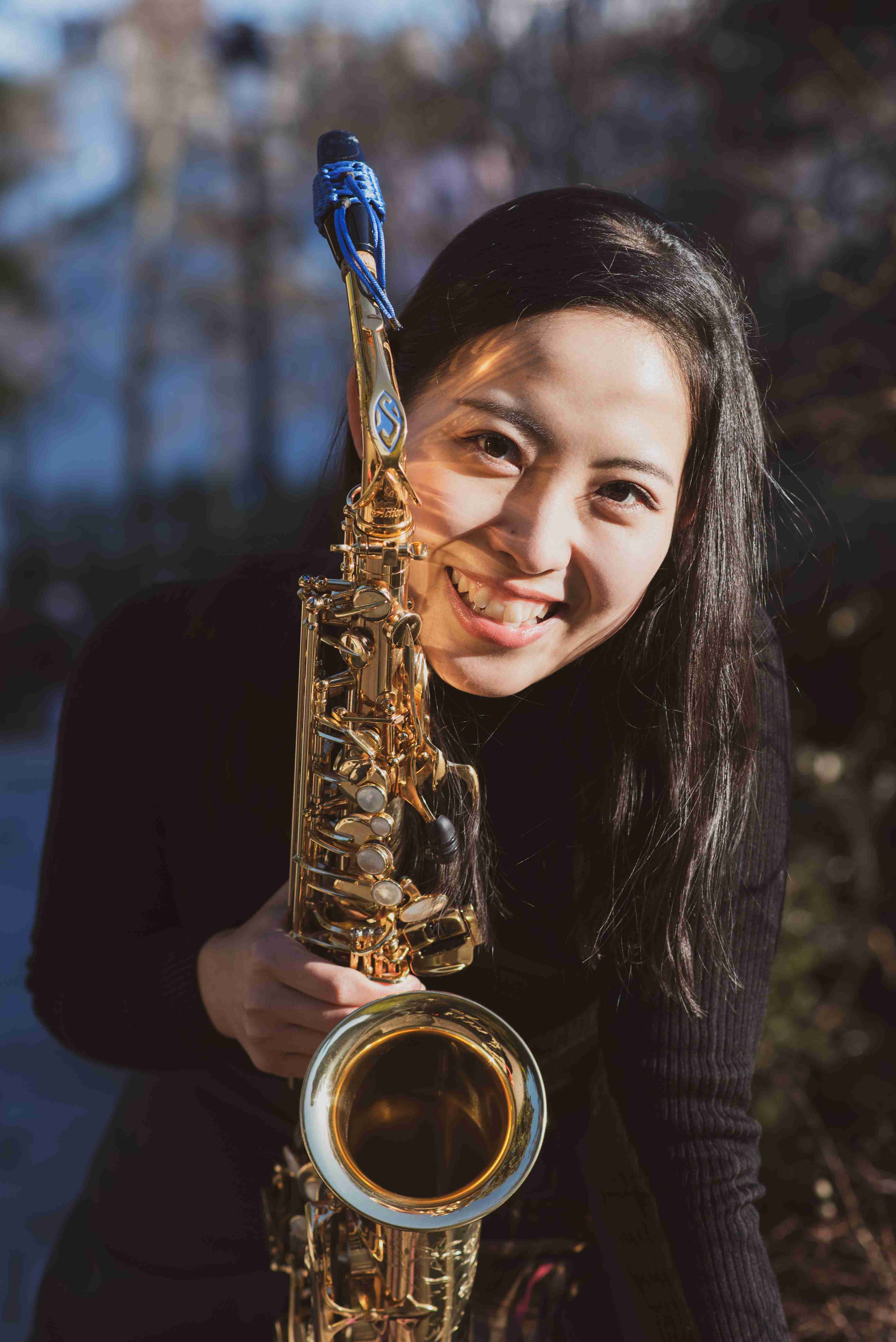 Miho Hakamada was born in Ichinomiya in Japan. She started learning the saxophone at the age of 10 as member of a symphonic band and receives her first lesson at the age of 12.
Miho Hakamada was born in Ichinomiya in Japan. She started learning the saxophone at the age of 10 as member of a symphonic band and receives her first lesson at the age of 12.


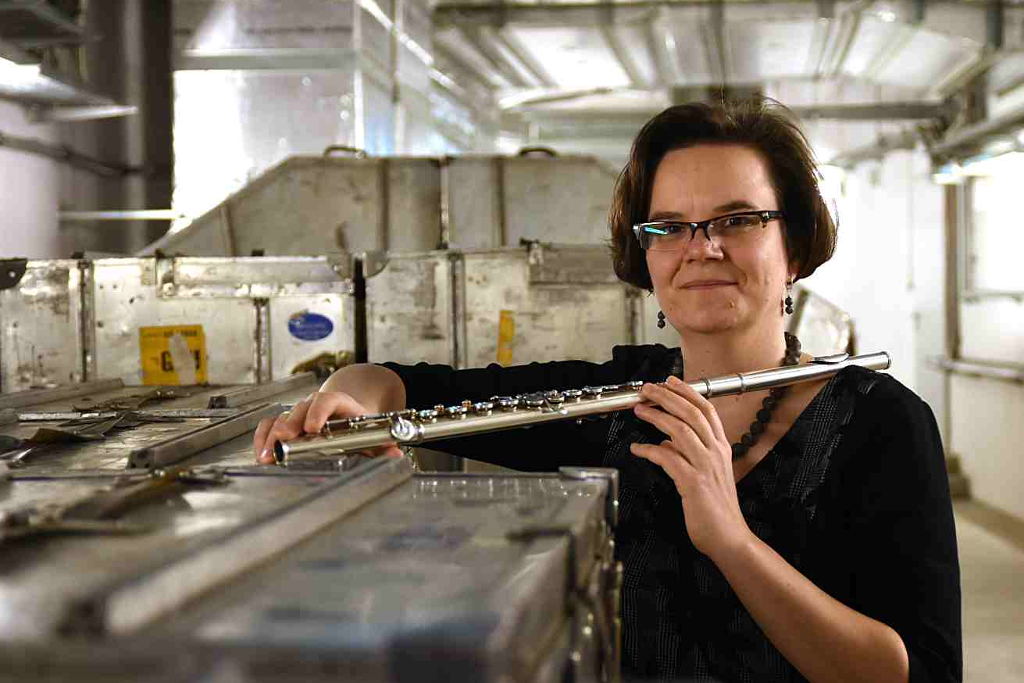 Flutist from Poland, Alicja Molitorys enjoys an active career as a soloist, chamber musician, orchestral player, and teacher. Since 2000 she has held the position of the principal flutist of the Orkiestra Muzyki Nowej (New Music Orchestra) with whom she performed at international festivals of contemporary music in Poland, across Europe and China. With the orchestra she has recorded CD's for Polish Radio, Decca, DUX and Aurora.
Flutist from Poland, Alicja Molitorys enjoys an active career as a soloist, chamber musician, orchestral player, and teacher. Since 2000 she has held the position of the principal flutist of the Orkiestra Muzyki Nowej (New Music Orchestra) with whom she performed at international festivals of contemporary music in Poland, across Europe and China. With the orchestra she has recorded CD's for Polish Radio, Decca, DUX and Aurora.
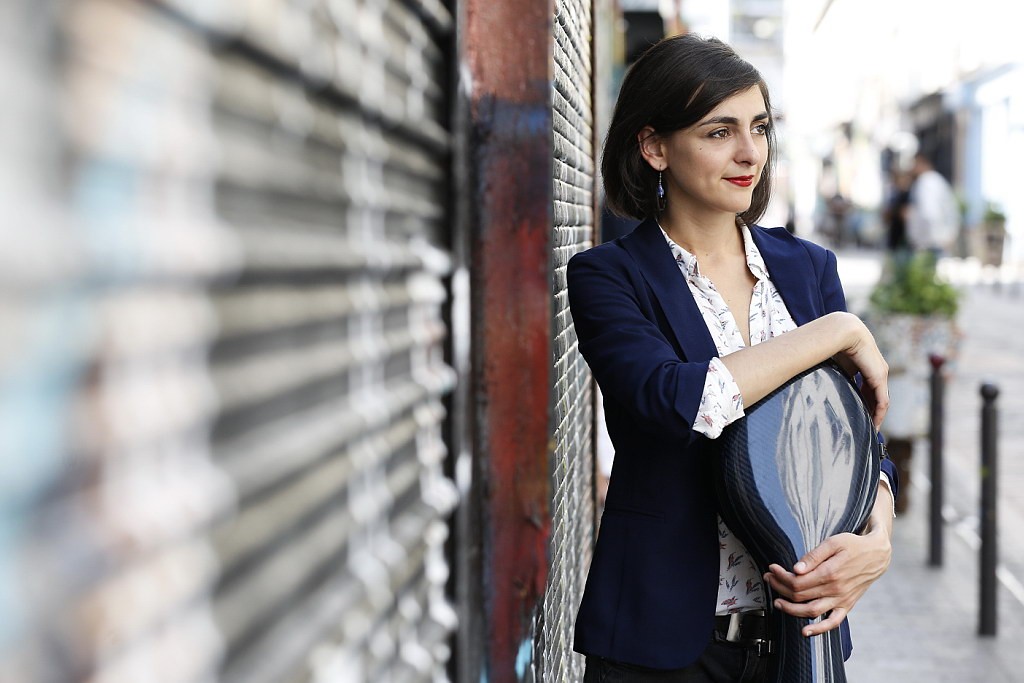
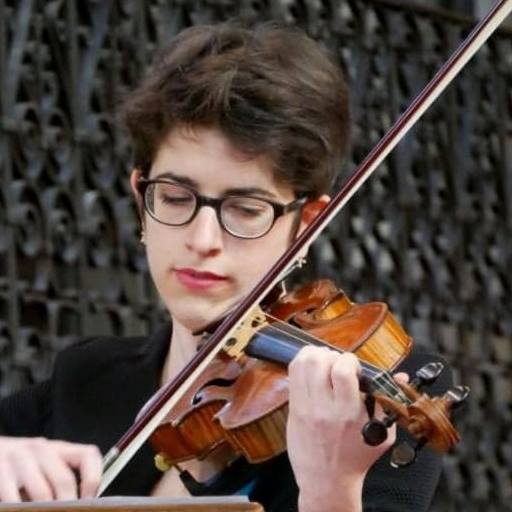
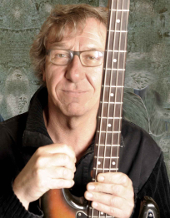
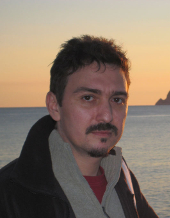 Sergio Blardony was born in Madrid in 1965. He studies composition with R. J. de Vittorio and –for four years- with J. L. de Delás at the Alcalá de Henares University. He has also attended both composition and analysis courses with Heinz-Klaus Metzger, Rainer Riehn, Helmut Lachenmann, Enrico Fubini, Luis de Pablo, etc.
Sergio Blardony was born in Madrid in 1965. He studies composition with R. J. de Vittorio and –for four years- with J. L. de Delás at the Alcalá de Henares University. He has also attended both composition and analysis courses with Heinz-Klaus Metzger, Rainer Riehn, Helmut Lachenmann, Enrico Fubini, Luis de Pablo, etc.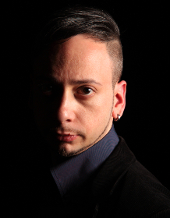 Maurilio Cacciatore’s music stems out of a combination of acoustical instruments with tools for digital music. It also incorporates electromechanical objects and uses various resources of informatics. It results in complex, multi-layered texture, presenting on the surface classical instruments and electronics, while containing an inner core of hybrid and non conventional techniques. Beyond the conventional standard of spatialization, Maurilio Cacciatore’s loudspeaker setups explore non-coded solutions that integrate hardware and software within various musical contents.
Maurilio Cacciatore’s music stems out of a combination of acoustical instruments with tools for digital music. It also incorporates electromechanical objects and uses various resources of informatics. It results in complex, multi-layered texture, presenting on the surface classical instruments and electronics, while containing an inner core of hybrid and non conventional techniques. Beyond the conventional standard of spatialization, Maurilio Cacciatore’s loudspeaker setups explore non-coded solutions that integrate hardware and software within various musical contents.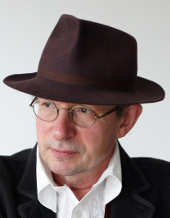
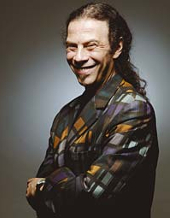
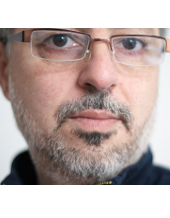 Nikos Koutrouvidis was born in Athens in 1966 and he lives in Paris since 1994. Initially a trained engineer, he does a degree in film and theatre composition from Filipos Nakas Conservatory of Athens, and he writes several works for films and plays. A degree in composition from the National Conservatory of the region of Strasbourg in Ivan Fedele’s class, he is awarded the first prize in Musical Acoustics at the Conservatoire National Supérieur de Musique et de Danse de Paris in Michèle Castellengo’s class. He also attends the ATIAM (Acoustics, signal treatment and informatics applied to music) course at Ircam. In 1998, he is composer in residency at ACROE-ICA (Association pour la Création et la Recherche sur les Outils d’Expression - Ingénierie de la Création Artistique) under the direction of Claude Cadoz in Grenoble. In 2000 he creates the Syntono association whose purpose is creation, diffusion and promotion of contemporary music and with which he organises the “Rencontres Internationales Syntono entre compositeurs et interprètes” from 2000 to 2007. In 2004 he is Christine Groult’s assistant in the class of electroacoustics at the Conservatory of Pantin. In 2013 he launches Synoork (a Syntono computer orchestra) which aims mainly to sensitize professional and amateur musicians to the role of the computer as a musical instrument in a transdisciplinary emsemble. With every new piece, pedagogical workshops on sensitizing to music and computers, on intiation do musical programming (MAX/MSP and PureData), on electronic performing and improvisation, are proposed. Sensitive to different paths in contemporary creation, and more specifically to relations between music, live performance and technology, Nikos Koutrouvidis’s composing work gravitates around research on musical time, and more precisely, the notion of sound and musical temporality. Since 2010, he works mainly on the creations of performances combining music and technology. It is in this new perspective that he has already created four works: the musical tale Poirette for a storyteller and a real-time computer (2012), the performance L’avenir du silence for an actress, a saxophonist, a percussionist, electronics and real-time video (2013), the musical performance Ecoman for a storyteller and two computers (2015) and Ubique for cello, saxophone and a computer orchestra (2016).
Nikos Koutrouvidis was born in Athens in 1966 and he lives in Paris since 1994. Initially a trained engineer, he does a degree in film and theatre composition from Filipos Nakas Conservatory of Athens, and he writes several works for films and plays. A degree in composition from the National Conservatory of the region of Strasbourg in Ivan Fedele’s class, he is awarded the first prize in Musical Acoustics at the Conservatoire National Supérieur de Musique et de Danse de Paris in Michèle Castellengo’s class. He also attends the ATIAM (Acoustics, signal treatment and informatics applied to music) course at Ircam. In 1998, he is composer in residency at ACROE-ICA (Association pour la Création et la Recherche sur les Outils d’Expression - Ingénierie de la Création Artistique) under the direction of Claude Cadoz in Grenoble. In 2000 he creates the Syntono association whose purpose is creation, diffusion and promotion of contemporary music and with which he organises the “Rencontres Internationales Syntono entre compositeurs et interprètes” from 2000 to 2007. In 2004 he is Christine Groult’s assistant in the class of electroacoustics at the Conservatory of Pantin. In 2013 he launches Synoork (a Syntono computer orchestra) which aims mainly to sensitize professional and amateur musicians to the role of the computer as a musical instrument in a transdisciplinary emsemble. With every new piece, pedagogical workshops on sensitizing to music and computers, on intiation do musical programming (MAX/MSP and PureData), on electronic performing and improvisation, are proposed. Sensitive to different paths in contemporary creation, and more specifically to relations between music, live performance and technology, Nikos Koutrouvidis’s composing work gravitates around research on musical time, and more precisely, the notion of sound and musical temporality. Since 2010, he works mainly on the creations of performances combining music and technology. It is in this new perspective that he has already created four works: the musical tale Poirette for a storyteller and a real-time computer (2012), the performance L’avenir du silence for an actress, a saxophonist, a percussionist, electronics and real-time video (2013), the musical performance Ecoman for a storyteller and two computers (2015) and Ubique for cello, saxophone and a computer orchestra (2016).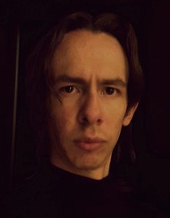 Luis C. Martinez Wilde (1986) is a Bolivian composer and music researcher. He studied composition under the guidance of Gastón Arce Sejas at Loyola University (Bolivia) and later with Alberto Villalpando. During his studying years he began experimenting with electroacoustic music, area in which he specialized by taking courses and workshops with different composers and sound artists. His catalogue includes works for live electronics, acousmatic, mixed and generative music, as well as choral and chamber music. His pieces have been presented in different festivals in Latin America and Europe.
Luis C. Martinez Wilde (1986) is a Bolivian composer and music researcher. He studied composition under the guidance of Gastón Arce Sejas at Loyola University (Bolivia) and later with Alberto Villalpando. During his studying years he began experimenting with electroacoustic music, area in which he specialized by taking courses and workshops with different composers and sound artists. His catalogue includes works for live electronics, acousmatic, mixed and generative music, as well as choral and chamber music. His pieces have been presented in different festivals in Latin America and Europe.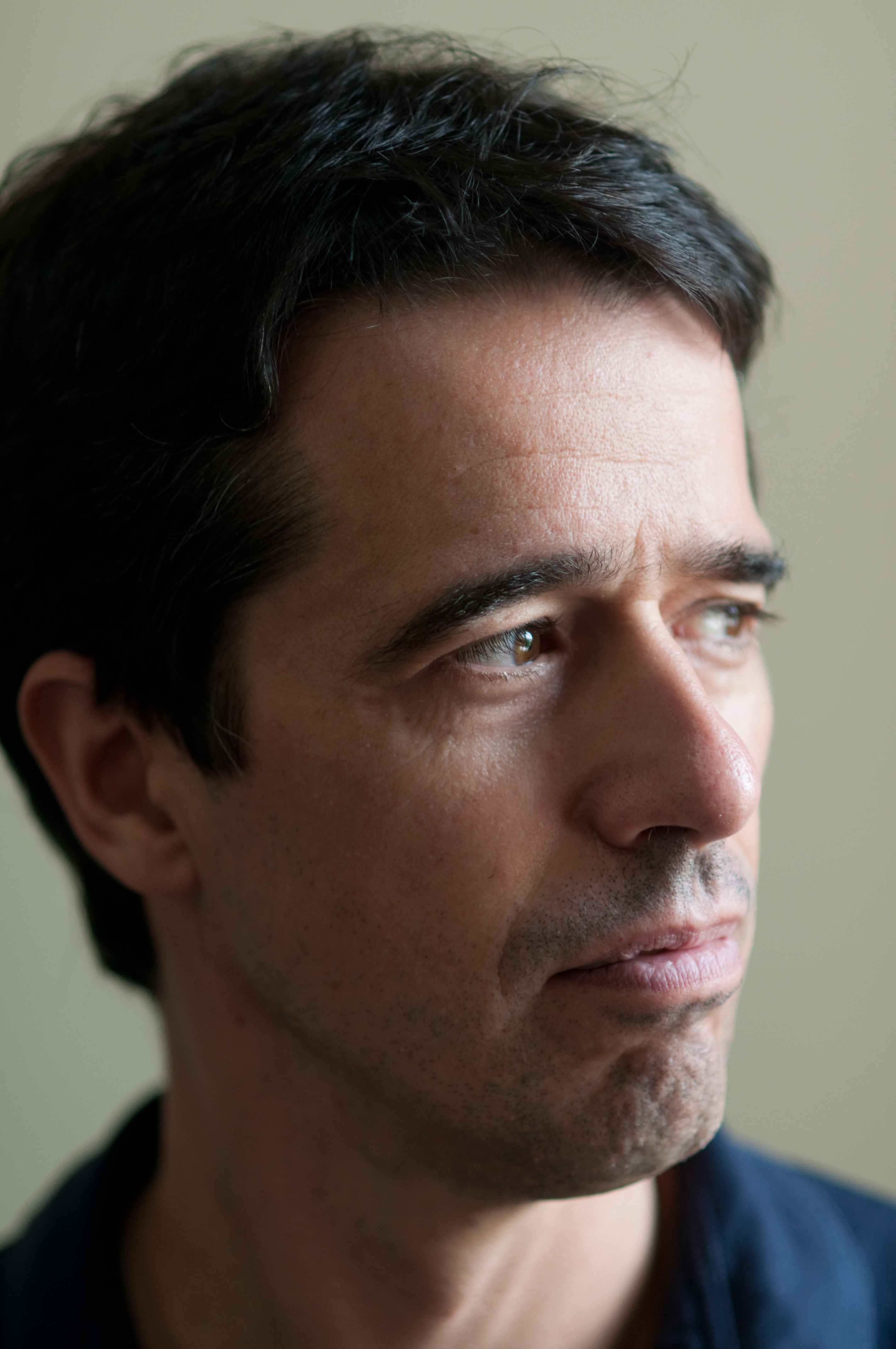 João Pedro Oliveira (born 1959) studied organ, composition and architecture in Lisbon. Ph.D. in music (composition) at the University of New York at Stony Brook. His works include a chamber opera, a Requiem, several orchestral works, three string quartets, chamber music, music for solo instrument, electroacoustic music and experimental video. A recipient of numerous national and international awards, including three awards at the Electroacoustic Music Competition in Bourges, and the prestigious Magisterium in the same competition, the Giga-Hertz Award, the first prize in Metamorphoses, the 1st Prize in the Musica Nova Competition, etc .. his music is played all over the world, and most of his works were commissioned by prestigious international institutions. He is a full professor at the Federal University of Minas Gerais (Brazil) and professor at the University of Aveiro (Portugal). He has also published several articles in national and international journals, and has written a book on the analytic theory of twentieth century music.
João Pedro Oliveira (born 1959) studied organ, composition and architecture in Lisbon. Ph.D. in music (composition) at the University of New York at Stony Brook. His works include a chamber opera, a Requiem, several orchestral works, three string quartets, chamber music, music for solo instrument, electroacoustic music and experimental video. A recipient of numerous national and international awards, including three awards at the Electroacoustic Music Competition in Bourges, and the prestigious Magisterium in the same competition, the Giga-Hertz Award, the first prize in Metamorphoses, the 1st Prize in the Musica Nova Competition, etc .. his music is played all over the world, and most of his works were commissioned by prestigious international institutions. He is a full professor at the Federal University of Minas Gerais (Brazil) and professor at the University of Aveiro (Portugal). He has also published several articles in national and international journals, and has written a book on the analytic theory of twentieth century music.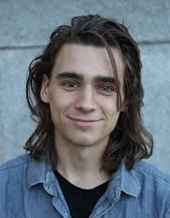 Theodore Teichman studied neurobiology and music composition in the BXA Intercollege Degrees Program. He is particularly interested in the systems of perceptual attention in the auditory system and how our brain learns how to make sense of complex auditory environments. His Dietrich College Honors Thesis, titled Training dynamics for sustained auditory selective attention, investigates mechanisms and patterns of learning for improvements on sustained auditory selective attention and how these paradigms used in the lab may have generalization to environmental forms of listening. His work has been played in California, Pennsylvania, Canada, Ukraine, the Netherlands, and the United Kingdom. The work “Haiku” has been selected to be included in the music presentation for the Moon Ark project and is being sent in a capsule to the moon as well as a tour of 14 European cities and the work Vanishing Point has been selected as a finalist in the KLK New Music Sacrarium Competition 2016 and was performed by the Lviv Philharmonic in October 2016. He is particularly interested in investigating the intersection of time, cultural context, and place in the formation and juxtaposition of musical and spatial meaning and how all these elements can be used to create highly evocative, personal, and immersive experiences of storytelling.
Theodore Teichman studied neurobiology and music composition in the BXA Intercollege Degrees Program. He is particularly interested in the systems of perceptual attention in the auditory system and how our brain learns how to make sense of complex auditory environments. His Dietrich College Honors Thesis, titled Training dynamics for sustained auditory selective attention, investigates mechanisms and patterns of learning for improvements on sustained auditory selective attention and how these paradigms used in the lab may have generalization to environmental forms of listening. His work has been played in California, Pennsylvania, Canada, Ukraine, the Netherlands, and the United Kingdom. The work “Haiku” has been selected to be included in the music presentation for the Moon Ark project and is being sent in a capsule to the moon as well as a tour of 14 European cities and the work Vanishing Point has been selected as a finalist in the KLK New Music Sacrarium Competition 2016 and was performed by the Lviv Philharmonic in October 2016. He is particularly interested in investigating the intersection of time, cultural context, and place in the formation and juxtaposition of musical and spatial meaning and how all these elements can be used to create highly evocative, personal, and immersive experiences of storytelling.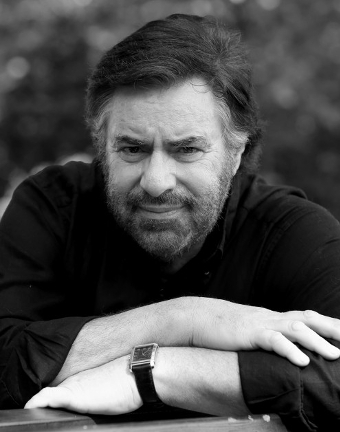
 Jean-François Charles creates where music and technology meet. From his work with poet Ruth Lepson and flutist Mario Caroli (Live Saturation, 2009) to the collaborative 52 minute sound track for Dziga Vertov’s film The Eleventh Year (with Nicolas Sidoroff and four other musicians, 2015), and to his work of musical chemistry with glass blower Benj Revis (Aqua ignis, 2018), he excels fusing diverse acoustic and electronic aural personalities.
Jean-François Charles creates where music and technology meet. From his work with poet Ruth Lepson and flutist Mario Caroli (Live Saturation, 2009) to the collaborative 52 minute sound track for Dziga Vertov’s film The Eleventh Year (with Nicolas Sidoroff and four other musicians, 2015), and to his work of musical chemistry with glass blower Benj Revis (Aqua ignis, 2018), he excels fusing diverse acoustic and electronic aural personalities. Hongshuo Fan is a Chinese sound artist and multimedia composer. He is currently doing his PhD at the NOVARS sound research centre (University of Manchester). He graduated from the Electronic Music Department at Sichuan Conservatory of Music and was a member of Sichuan Key Laboratory of Digital Media Arts.
Hongshuo Fan is a Chinese sound artist and multimedia composer. He is currently doing his PhD at the NOVARS sound research centre (University of Manchester). He graduated from the Electronic Music Department at Sichuan Conservatory of Music and was a member of Sichuan Key Laboratory of Digital Media Arts.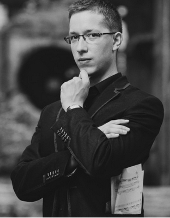
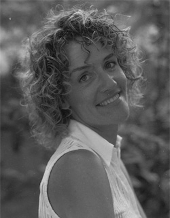
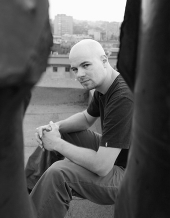 Krzysztof Wolek (b. 1976, Bytom, Poland) is a composer, improviser, and installation artist. He is currently working as an Associate Professor of Music Composition and a Director of Digital Composition Studies at the University of Louisville.
Krzysztof Wolek (b. 1976, Bytom, Poland) is a composer, improviser, and installation artist. He is currently working as an Associate Professor of Music Composition and a Director of Digital Composition Studies at the University of Louisville.